Leadership Journey: Reflective Report on Leadership Theories & Skills
VerifiedAdded on 2023/03/30
|22
|4217
|196
Report
AI Summary
This report explores the concept of reflection as a learning tool within organizations and its connection to various leadership theories and styles. It highlights the impact of class activities on self-understanding and leadership capacity. The coursework delves into different leadership theories, including tr...
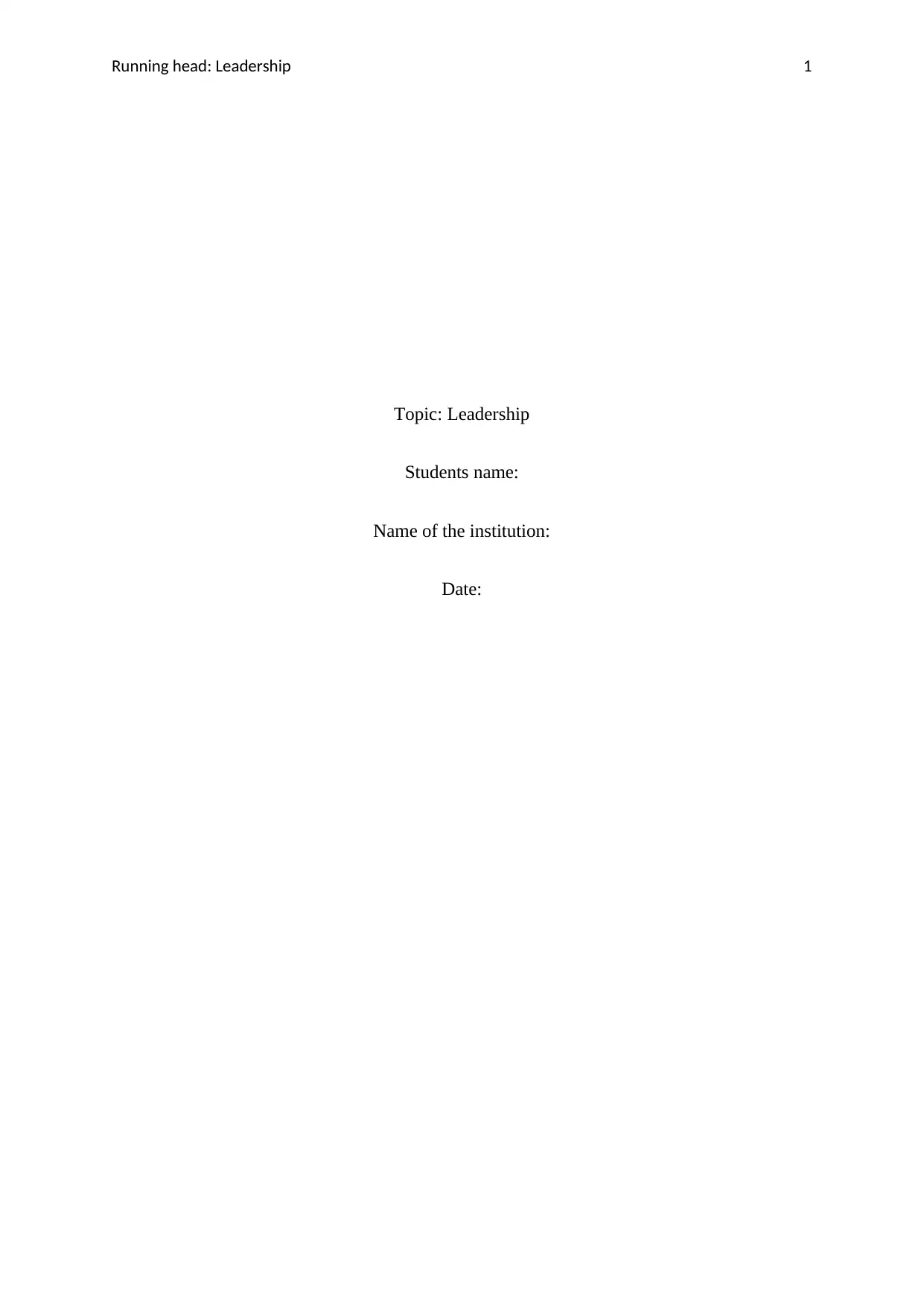
Running head: Leadership 1
Topic: Leadership
Students name:
Name of the institution:
Date:
Topic: Leadership
Students name:
Name of the institution:
Date:
Paraphrase This Document
Need a fresh take? Get an instant paraphrase of this document with our AI Paraphraser
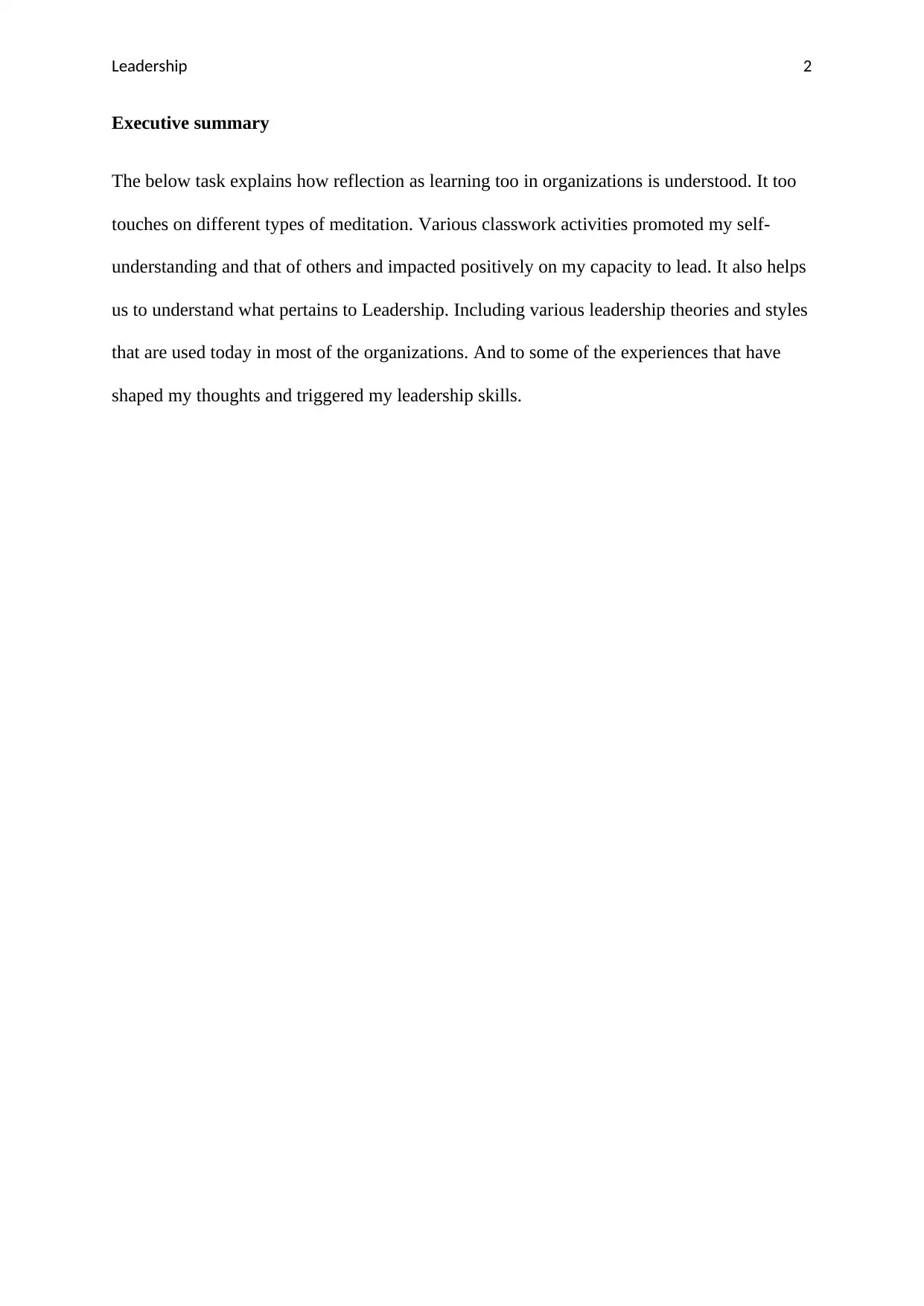
Leadership 2
Executive summary
The below task explains how reflection as learning too in organizations is understood. It too
touches on different types of meditation. Various classwork activities promoted my self-
understanding and that of others and impacted positively on my capacity to lead. It also helps
us to understand what pertains to Leadership. Including various leadership theories and styles
that are used today in most of the organizations. And to some of the experiences that have
shaped my thoughts and triggered my leadership skills.
Executive summary
The below task explains how reflection as learning too in organizations is understood. It too
touches on different types of meditation. Various classwork activities promoted my self-
understanding and that of others and impacted positively on my capacity to lead. It also helps
us to understand what pertains to Leadership. Including various leadership theories and styles
that are used today in most of the organizations. And to some of the experiences that have
shaped my thoughts and triggered my leadership skills.
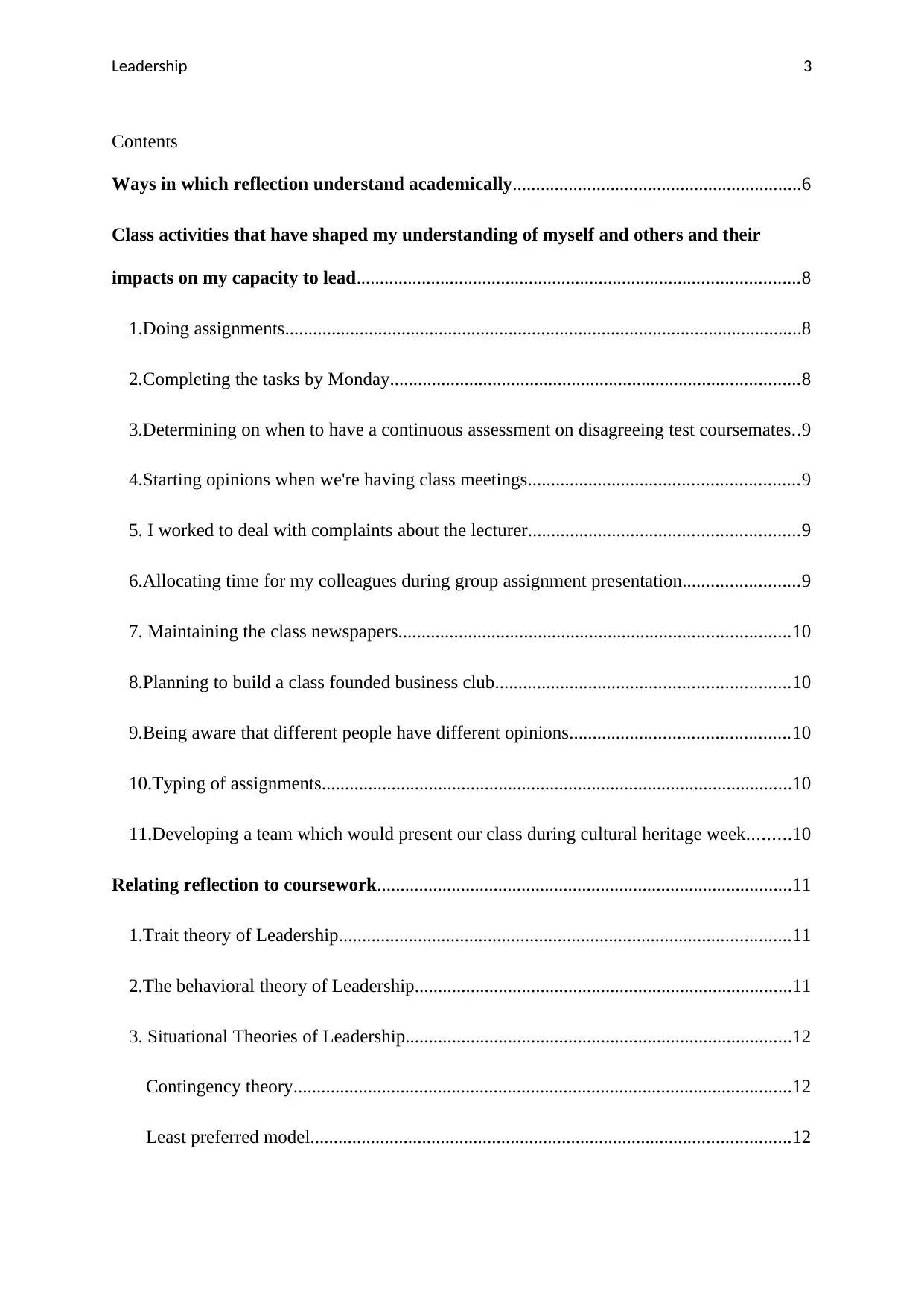
Leadership 3
Contents
Ways in which reflection understand academically..............................................................6
Class activities that have shaped my understanding of myself and others and their
impacts on my capacity to lead...............................................................................................8
1.Doing assignments...............................................................................................................8
2.Completing the tasks by Monday........................................................................................8
3.Determining on when to have a continuous assessment on disagreeing test coursemates..9
4.Starting opinions when we're having class meetings..........................................................9
5. I worked to deal with complaints about the lecturer..........................................................9
6.Allocating time for my colleagues during group assignment presentation.........................9
7. Maintaining the class newspapers....................................................................................10
8.Planning to build a class founded business club...............................................................10
9.Being aware that different people have different opinions...............................................10
10.Typing of assignments.....................................................................................................10
11.Developing a team which would present our class during cultural heritage week.........10
Relating reflection to coursework.........................................................................................11
1.Trait theory of Leadership.................................................................................................11
2.The behavioral theory of Leadership.................................................................................11
3. Situational Theories of Leadership...................................................................................12
Contingency theory...........................................................................................................12
Least preferred model.......................................................................................................12
Contents
Ways in which reflection understand academically..............................................................6
Class activities that have shaped my understanding of myself and others and their
impacts on my capacity to lead...............................................................................................8
1.Doing assignments...............................................................................................................8
2.Completing the tasks by Monday........................................................................................8
3.Determining on when to have a continuous assessment on disagreeing test coursemates..9
4.Starting opinions when we're having class meetings..........................................................9
5. I worked to deal with complaints about the lecturer..........................................................9
6.Allocating time for my colleagues during group assignment presentation.........................9
7. Maintaining the class newspapers....................................................................................10
8.Planning to build a class founded business club...............................................................10
9.Being aware that different people have different opinions...............................................10
10.Typing of assignments.....................................................................................................10
11.Developing a team which would present our class during cultural heritage week.........10
Relating reflection to coursework.........................................................................................11
1.Trait theory of Leadership.................................................................................................11
2.The behavioral theory of Leadership.................................................................................11
3. Situational Theories of Leadership...................................................................................12
Contingency theory...........................................................................................................12
Least preferred model.......................................................................................................12
You're viewing a preview
Unlock full access by subscribing today!
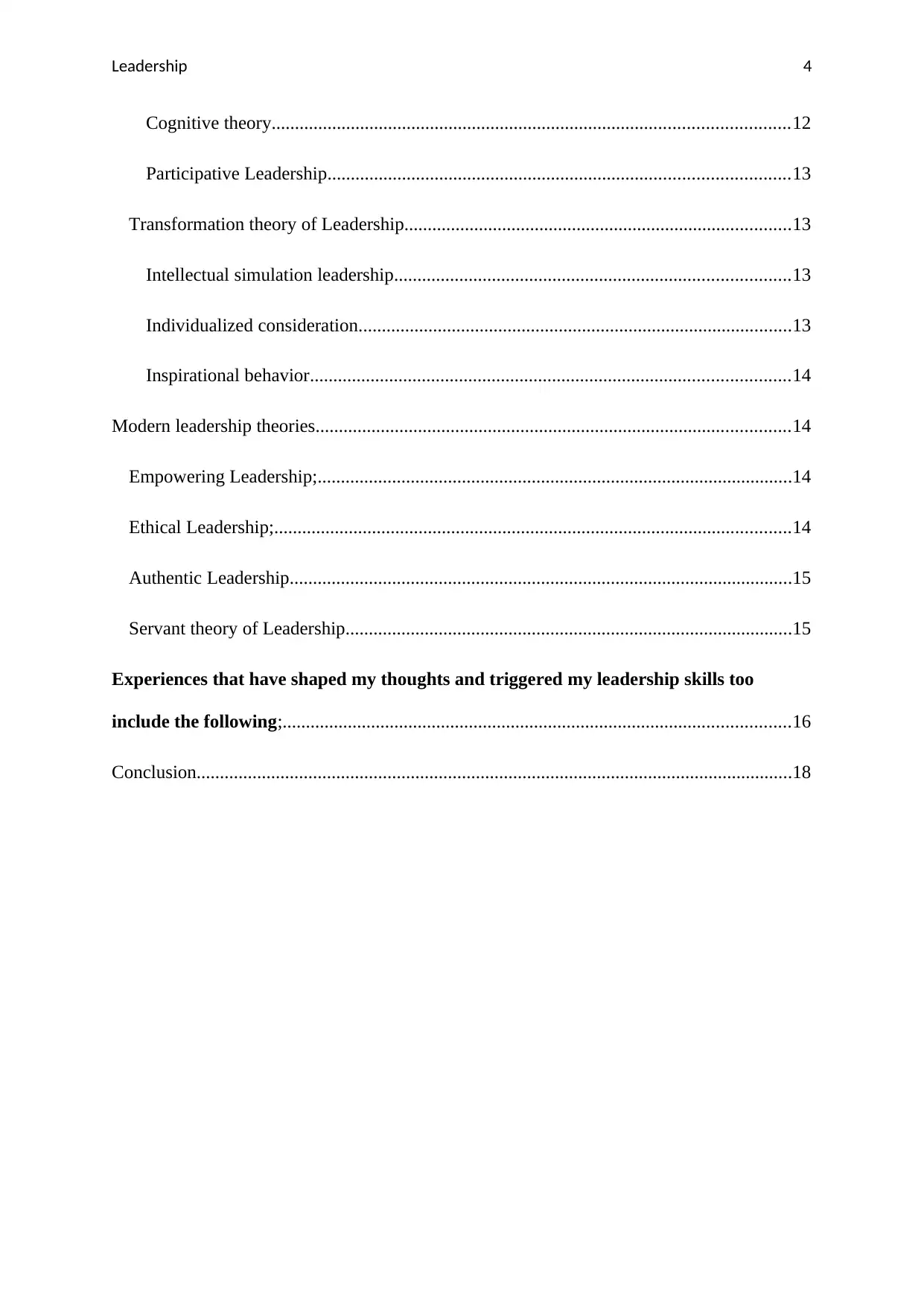
Leadership 4
Cognitive theory...............................................................................................................12
Participative Leadership...................................................................................................13
Transformation theory of Leadership...................................................................................13
Intellectual simulation leadership.....................................................................................13
Individualized consideration.............................................................................................13
Inspirational behavior.......................................................................................................14
Modern leadership theories......................................................................................................14
Empowering Leadership;......................................................................................................14
Ethical Leadership;...............................................................................................................14
Authentic Leadership............................................................................................................15
Servant theory of Leadership................................................................................................15
Experiences that have shaped my thoughts and triggered my leadership skills too
include the following;.............................................................................................................16
Conclusion................................................................................................................................18
Cognitive theory...............................................................................................................12
Participative Leadership...................................................................................................13
Transformation theory of Leadership...................................................................................13
Intellectual simulation leadership.....................................................................................13
Individualized consideration.............................................................................................13
Inspirational behavior.......................................................................................................14
Modern leadership theories......................................................................................................14
Empowering Leadership;......................................................................................................14
Ethical Leadership;...............................................................................................................14
Authentic Leadership............................................................................................................15
Servant theory of Leadership................................................................................................15
Experiences that have shaped my thoughts and triggered my leadership skills too
include the following;.............................................................................................................16
Conclusion................................................................................................................................18
Paraphrase This Document
Need a fresh take? Get an instant paraphrase of this document with our AI Paraphraser

Leadership 5
Executive summary
The below task explains how reflection as learning too in organizations is understood. It too
touches on different types of meditation. Various classwork activities promoted my self-
understanding and that of others and impacted positively on my capacity to lead. It also helps
us to understand what pertains to Leadership. Including various leadership theories and styles
that are used today in most of the organizations. And to some of the experiences that have
shaped my thoughts and triggered my leadership skills.
Executive summary
The below task explains how reflection as learning too in organizations is understood. It too
touches on different types of meditation. Various classwork activities promoted my self-
understanding and that of others and impacted positively on my capacity to lead. It also helps
us to understand what pertains to Leadership. Including various leadership theories and styles
that are used today in most of the organizations. And to some of the experiences that have
shaped my thoughts and triggered my leadership skills.

Leadership 6
You're viewing a preview
Unlock full access by subscribing today!
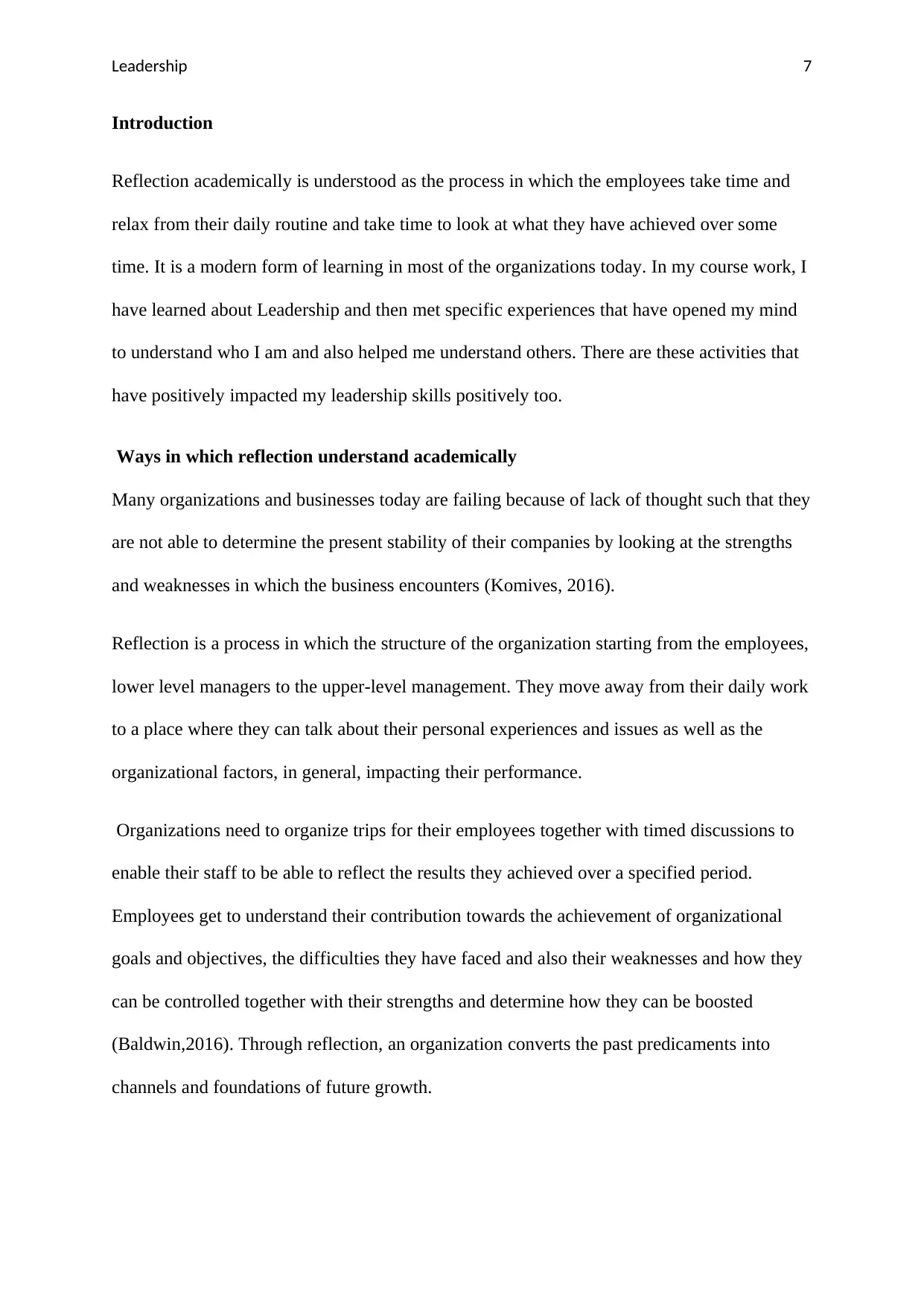
Leadership 7
Introduction
Reflection academically is understood as the process in which the employees take time and
relax from their daily routine and take time to look at what they have achieved over some
time. It is a modern form of learning in most of the organizations today. In my course work, I
have learned about Leadership and then met specific experiences that have opened my mind
to understand who I am and also helped me understand others. There are these activities that
have positively impacted my leadership skills positively too.
Ways in which reflection understand academically
Many organizations and businesses today are failing because of lack of thought such that they
are not able to determine the present stability of their companies by looking at the strengths
and weaknesses in which the business encounters (Komives, 2016).
Reflection is a process in which the structure of the organization starting from the employees,
lower level managers to the upper-level management. They move away from their daily work
to a place where they can talk about their personal experiences and issues as well as the
organizational factors, in general, impacting their performance.
Organizations need to organize trips for their employees together with timed discussions to
enable their staff to be able to reflect the results they achieved over a specified period.
Employees get to understand their contribution towards the achievement of organizational
goals and objectives, the difficulties they have faced and also their weaknesses and how they
can be controlled together with their strengths and determine how they can be boosted
(Baldwin,2016). Through reflection, an organization converts the past predicaments into
channels and foundations of future growth.
Introduction
Reflection academically is understood as the process in which the employees take time and
relax from their daily routine and take time to look at what they have achieved over some
time. It is a modern form of learning in most of the organizations today. In my course work, I
have learned about Leadership and then met specific experiences that have opened my mind
to understand who I am and also helped me understand others. There are these activities that
have positively impacted my leadership skills positively too.
Ways in which reflection understand academically
Many organizations and businesses today are failing because of lack of thought such that they
are not able to determine the present stability of their companies by looking at the strengths
and weaknesses in which the business encounters (Komives, 2016).
Reflection is a process in which the structure of the organization starting from the employees,
lower level managers to the upper-level management. They move away from their daily work
to a place where they can talk about their personal experiences and issues as well as the
organizational factors, in general, impacting their performance.
Organizations need to organize trips for their employees together with timed discussions to
enable their staff to be able to reflect the results they achieved over a specified period.
Employees get to understand their contribution towards the achievement of organizational
goals and objectives, the difficulties they have faced and also their weaknesses and how they
can be controlled together with their strengths and determine how they can be boosted
(Baldwin,2016). Through reflection, an organization converts the past predicaments into
channels and foundations of future growth.
Paraphrase This Document
Need a fresh take? Get an instant paraphrase of this document with our AI Paraphraser
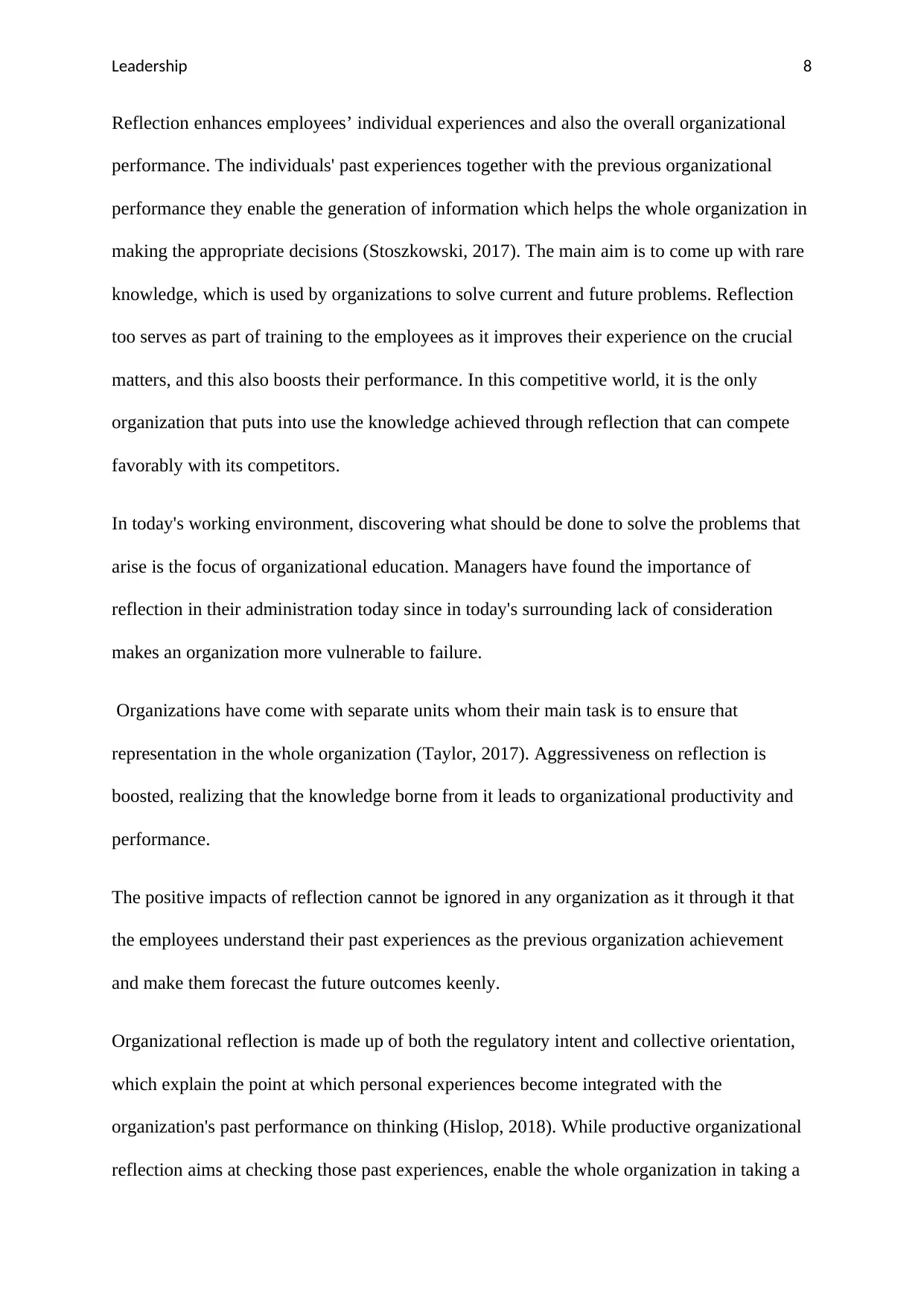
Leadership 8
Reflection enhances employees’ individual experiences and also the overall organizational
performance. The individuals' past experiences together with the previous organizational
performance they enable the generation of information which helps the whole organization in
making the appropriate decisions (Stoszkowski, 2017). The main aim is to come up with rare
knowledge, which is used by organizations to solve current and future problems. Reflection
too serves as part of training to the employees as it improves their experience on the crucial
matters, and this also boosts their performance. In this competitive world, it is the only
organization that puts into use the knowledge achieved through reflection that can compete
favorably with its competitors.
In today's working environment, discovering what should be done to solve the problems that
arise is the focus of organizational education. Managers have found the importance of
reflection in their administration today since in today's surrounding lack of consideration
makes an organization more vulnerable to failure.
Organizations have come with separate units whom their main task is to ensure that
representation in the whole organization (Taylor, 2017). Aggressiveness on reflection is
boosted, realizing that the knowledge borne from it leads to organizational productivity and
performance.
The positive impacts of reflection cannot be ignored in any organization as it through it that
the employees understand their past experiences as the previous organization achievement
and make them forecast the future outcomes keenly.
Organizational reflection is made up of both the regulatory intent and collective orientation,
which explain the point at which personal experiences become integrated with the
organization's past performance on thinking (Hislop, 2018). While productive organizational
reflection aims at checking those past experiences, enable the whole organization in taking a
Reflection enhances employees’ individual experiences and also the overall organizational
performance. The individuals' past experiences together with the previous organizational
performance they enable the generation of information which helps the whole organization in
making the appropriate decisions (Stoszkowski, 2017). The main aim is to come up with rare
knowledge, which is used by organizations to solve current and future problems. Reflection
too serves as part of training to the employees as it improves their experience on the crucial
matters, and this also boosts their performance. In this competitive world, it is the only
organization that puts into use the knowledge achieved through reflection that can compete
favorably with its competitors.
In today's working environment, discovering what should be done to solve the problems that
arise is the focus of organizational education. Managers have found the importance of
reflection in their administration today since in today's surrounding lack of consideration
makes an organization more vulnerable to failure.
Organizations have come with separate units whom their main task is to ensure that
representation in the whole organization (Taylor, 2017). Aggressiveness on reflection is
boosted, realizing that the knowledge borne from it leads to organizational productivity and
performance.
The positive impacts of reflection cannot be ignored in any organization as it through it that
the employees understand their past experiences as the previous organization achievement
and make them forecast the future outcomes keenly.
Organizational reflection is made up of both the regulatory intent and collective orientation,
which explain the point at which personal experiences become integrated with the
organization's past performance on thinking (Hislop, 2018). While productive organizational
reflection aims at checking those past experiences, enable the whole organization in taking a
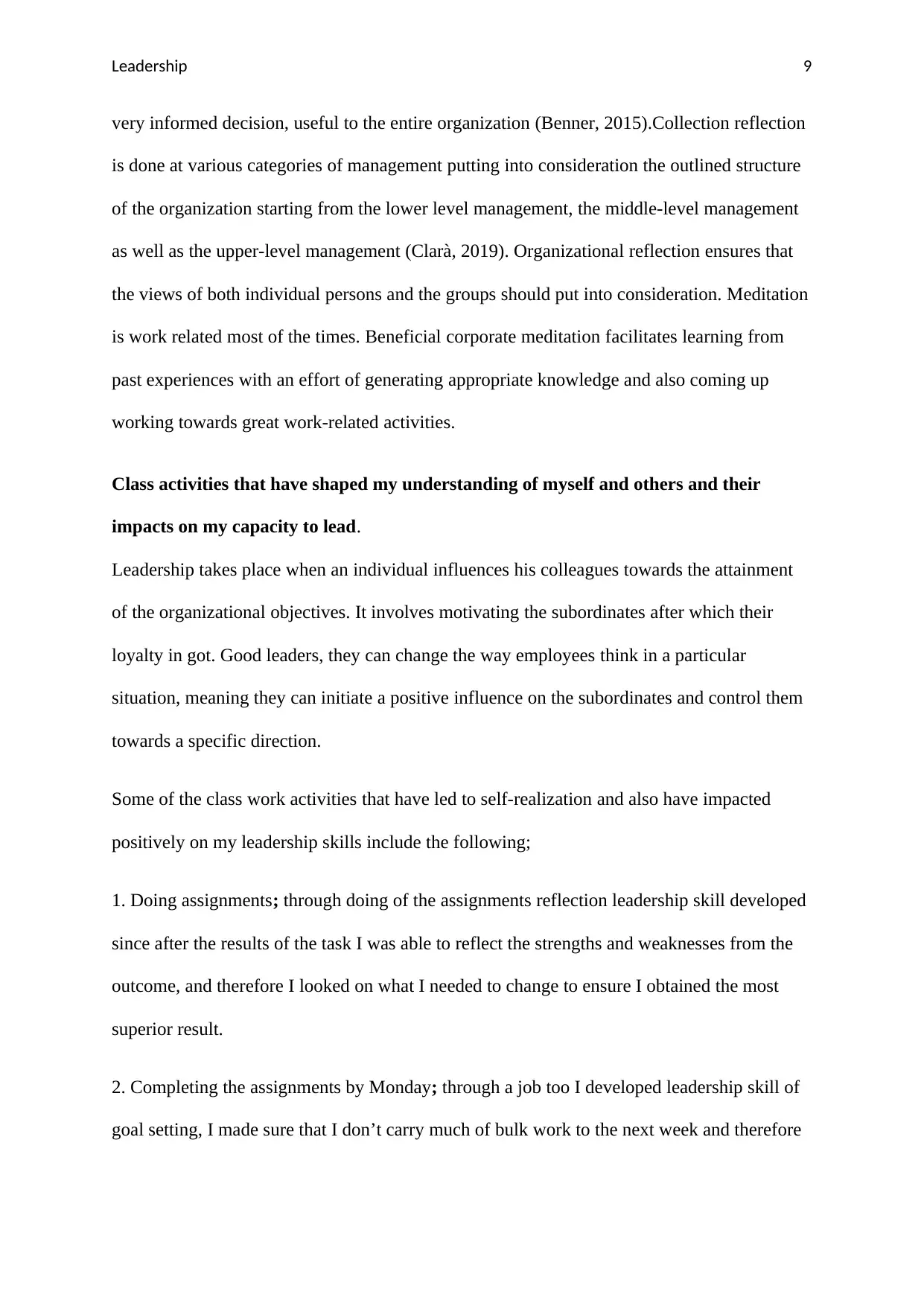
Leadership 9
very informed decision, useful to the entire organization (Benner, 2015).Collection reflection
is done at various categories of management putting into consideration the outlined structure
of the organization starting from the lower level management, the middle-level management
as well as the upper-level management (Clarà, 2019). Organizational reflection ensures that
the views of both individual persons and the groups should put into consideration. Meditation
is work related most of the times. Beneficial corporate meditation facilitates learning from
past experiences with an effort of generating appropriate knowledge and also coming up
working towards great work-related activities.
Class activities that have shaped my understanding of myself and others and their
impacts on my capacity to lead.
Leadership takes place when an individual influences his colleagues towards the attainment
of the organizational objectives. It involves motivating the subordinates after which their
loyalty in got. Good leaders, they can change the way employees think in a particular
situation, meaning they can initiate a positive influence on the subordinates and control them
towards a specific direction.
Some of the class work activities that have led to self-realization and also have impacted
positively on my leadership skills include the following;
1. Doing assignments; through doing of the assignments reflection leadership skill developed
since after the results of the task I was able to reflect the strengths and weaknesses from the
outcome, and therefore I looked on what I needed to change to ensure I obtained the most
superior result.
2. Completing the assignments by Monday; through a job too I developed leadership skill of
goal setting, I made sure that I don’t carry much of bulk work to the next week and therefore
very informed decision, useful to the entire organization (Benner, 2015).Collection reflection
is done at various categories of management putting into consideration the outlined structure
of the organization starting from the lower level management, the middle-level management
as well as the upper-level management (Clarà, 2019). Organizational reflection ensures that
the views of both individual persons and the groups should put into consideration. Meditation
is work related most of the times. Beneficial corporate meditation facilitates learning from
past experiences with an effort of generating appropriate knowledge and also coming up
working towards great work-related activities.
Class activities that have shaped my understanding of myself and others and their
impacts on my capacity to lead.
Leadership takes place when an individual influences his colleagues towards the attainment
of the organizational objectives. It involves motivating the subordinates after which their
loyalty in got. Good leaders, they can change the way employees think in a particular
situation, meaning they can initiate a positive influence on the subordinates and control them
towards a specific direction.
Some of the class work activities that have led to self-realization and also have impacted
positively on my leadership skills include the following;
1. Doing assignments; through doing of the assignments reflection leadership skill developed
since after the results of the task I was able to reflect the strengths and weaknesses from the
outcome, and therefore I looked on what I needed to change to ensure I obtained the most
superior result.
2. Completing the assignments by Monday; through a job too I developed leadership skill of
goal setting, I made sure that I don’t carry much of bulk work to the next week and therefore
You're viewing a preview
Unlock full access by subscribing today!
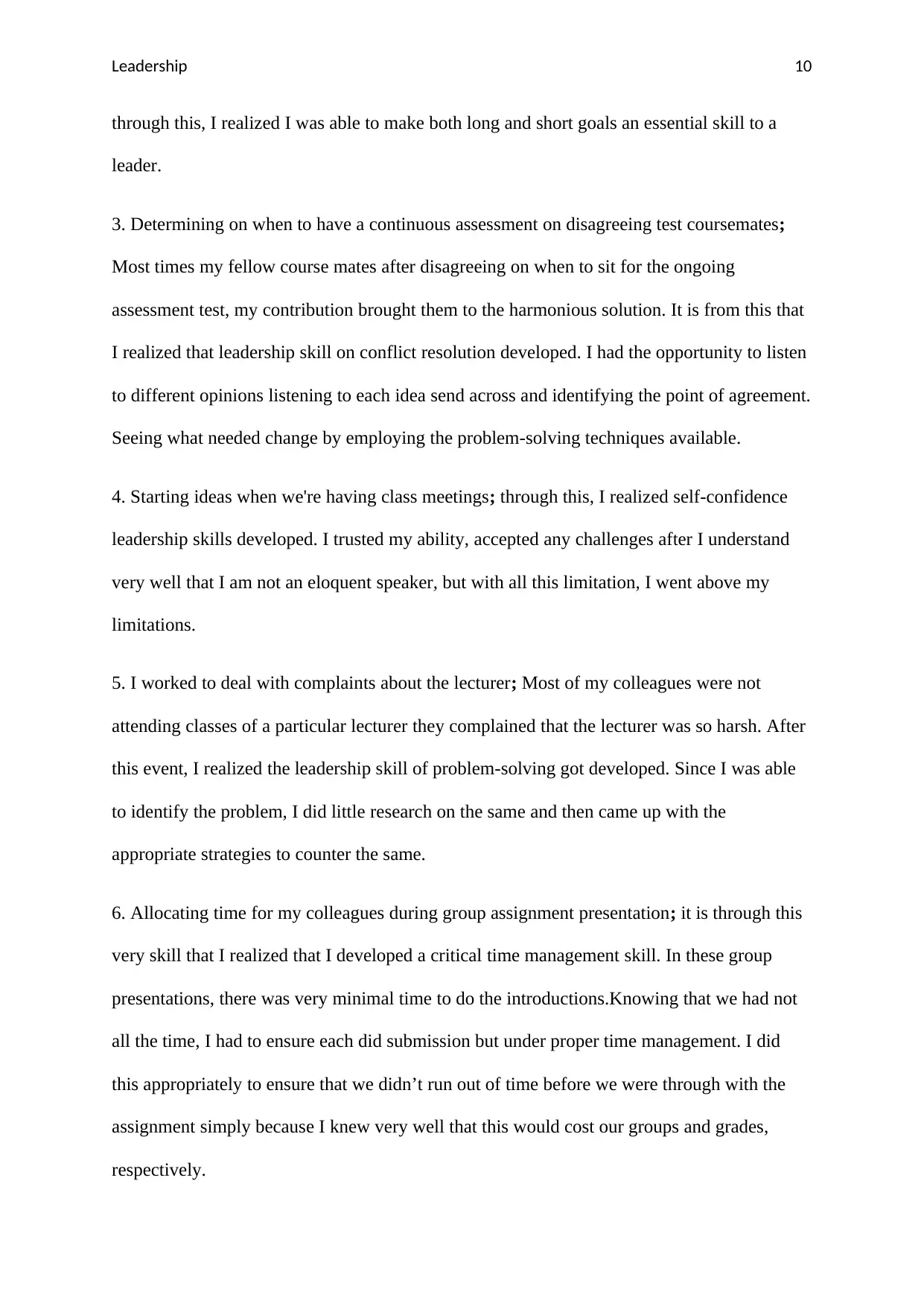
Leadership 10
through this, I realized I was able to make both long and short goals an essential skill to a
leader.
3. Determining on when to have a continuous assessment on disagreeing test coursemates;
Most times my fellow course mates after disagreeing on when to sit for the ongoing
assessment test, my contribution brought them to the harmonious solution. It is from this that
I realized that leadership skill on conflict resolution developed. I had the opportunity to listen
to different opinions listening to each idea send across and identifying the point of agreement.
Seeing what needed change by employing the problem-solving techniques available.
4. Starting ideas when we're having class meetings; through this, I realized self-confidence
leadership skills developed. I trusted my ability, accepted any challenges after I understand
very well that I am not an eloquent speaker, but with all this limitation, I went above my
limitations.
5. I worked to deal with complaints about the lecturer; Most of my colleagues were not
attending classes of a particular lecturer they complained that the lecturer was so harsh. After
this event, I realized the leadership skill of problem-solving got developed. Since I was able
to identify the problem, I did little research on the same and then came up with the
appropriate strategies to counter the same.
6. Allocating time for my colleagues during group assignment presentation; it is through this
very skill that I realized that I developed a critical time management skill. In these group
presentations, there was very minimal time to do the introductions.Knowing that we had not
all the time, I had to ensure each did submission but under proper time management. I did
this appropriately to ensure that we didn’t run out of time before we were through with the
assignment simply because I knew very well that this would cost our groups and grades,
respectively.
through this, I realized I was able to make both long and short goals an essential skill to a
leader.
3. Determining on when to have a continuous assessment on disagreeing test coursemates;
Most times my fellow course mates after disagreeing on when to sit for the ongoing
assessment test, my contribution brought them to the harmonious solution. It is from this that
I realized that leadership skill on conflict resolution developed. I had the opportunity to listen
to different opinions listening to each idea send across and identifying the point of agreement.
Seeing what needed change by employing the problem-solving techniques available.
4. Starting ideas when we're having class meetings; through this, I realized self-confidence
leadership skills developed. I trusted my ability, accepted any challenges after I understand
very well that I am not an eloquent speaker, but with all this limitation, I went above my
limitations.
5. I worked to deal with complaints about the lecturer; Most of my colleagues were not
attending classes of a particular lecturer they complained that the lecturer was so harsh. After
this event, I realized the leadership skill of problem-solving got developed. Since I was able
to identify the problem, I did little research on the same and then came up with the
appropriate strategies to counter the same.
6. Allocating time for my colleagues during group assignment presentation; it is through this
very skill that I realized that I developed a critical time management skill. In these group
presentations, there was very minimal time to do the introductions.Knowing that we had not
all the time, I had to ensure each did submission but under proper time management. I did
this appropriately to ensure that we didn’t run out of time before we were through with the
assignment simply because I knew very well that this would cost our groups and grades,
respectively.
Paraphrase This Document
Need a fresh take? Get an instant paraphrase of this document with our AI Paraphraser
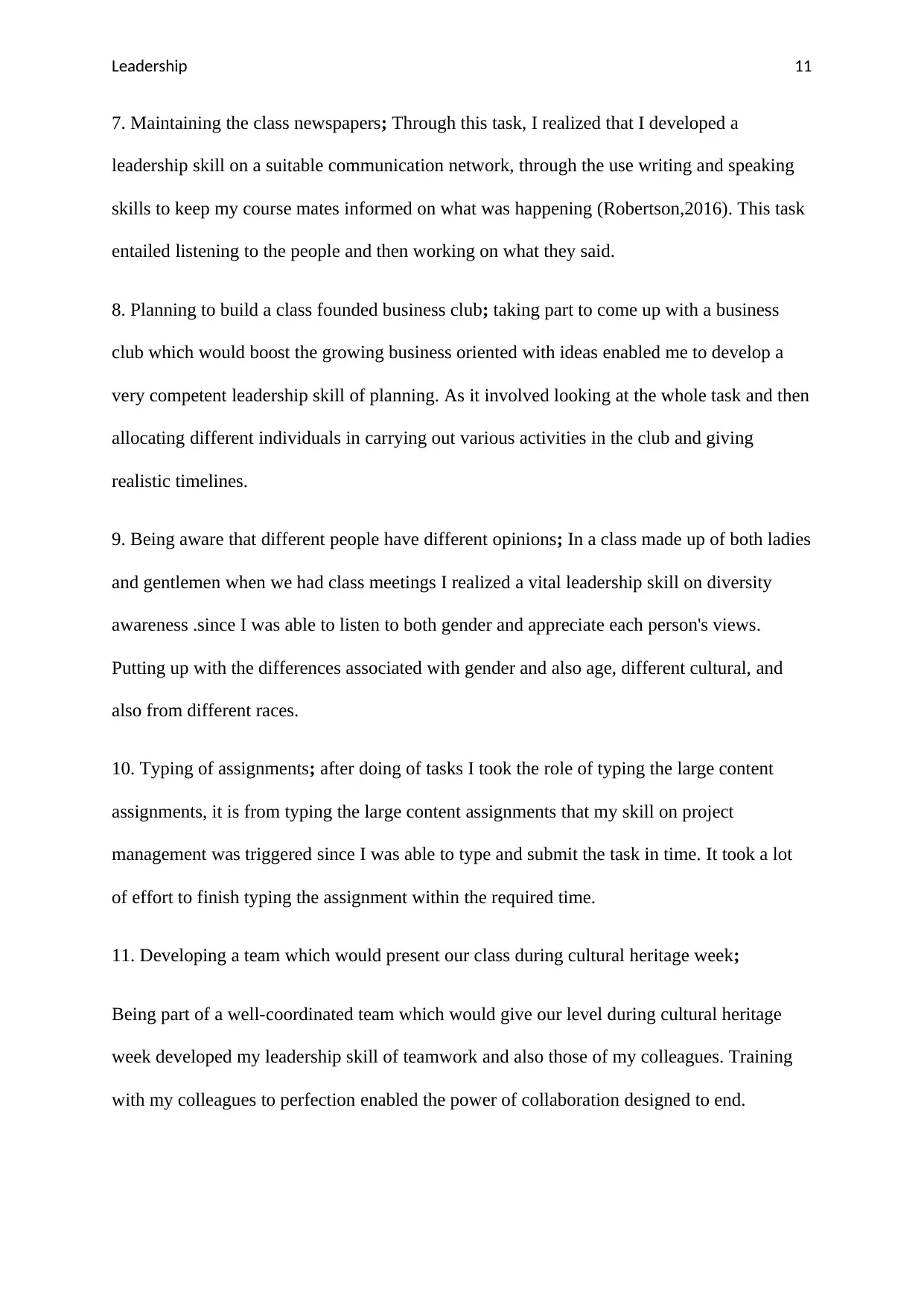
Leadership 11
7. Maintaining the class newspapers; Through this task, I realized that I developed a
leadership skill on a suitable communication network, through the use writing and speaking
skills to keep my course mates informed on what was happening (Robertson,2016). This task
entailed listening to the people and then working on what they said.
8. Planning to build a class founded business club; taking part to come up with a business
club which would boost the growing business oriented with ideas enabled me to develop a
very competent leadership skill of planning. As it involved looking at the whole task and then
allocating different individuals in carrying out various activities in the club and giving
realistic timelines.
9. Being aware that different people have different opinions; In a class made up of both ladies
and gentlemen when we had class meetings I realized a vital leadership skill on diversity
awareness .since I was able to listen to both gender and appreciate each person's views.
Putting up with the differences associated with gender and also age, different cultural, and
also from different races.
10. Typing of assignments; after doing of tasks I took the role of typing the large content
assignments, it is from typing the large content assignments that my skill on project
management was triggered since I was able to type and submit the task in time. It took a lot
of effort to finish typing the assignment within the required time.
11. Developing a team which would present our class during cultural heritage week;
Being part of a well-coordinated team which would give our level during cultural heritage
week developed my leadership skill of teamwork and also those of my colleagues. Training
with my colleagues to perfection enabled the power of collaboration designed to end.
7. Maintaining the class newspapers; Through this task, I realized that I developed a
leadership skill on a suitable communication network, through the use writing and speaking
skills to keep my course mates informed on what was happening (Robertson,2016). This task
entailed listening to the people and then working on what they said.
8. Planning to build a class founded business club; taking part to come up with a business
club which would boost the growing business oriented with ideas enabled me to develop a
very competent leadership skill of planning. As it involved looking at the whole task and then
allocating different individuals in carrying out various activities in the club and giving
realistic timelines.
9. Being aware that different people have different opinions; In a class made up of both ladies
and gentlemen when we had class meetings I realized a vital leadership skill on diversity
awareness .since I was able to listen to both gender and appreciate each person's views.
Putting up with the differences associated with gender and also age, different cultural, and
also from different races.
10. Typing of assignments; after doing of tasks I took the role of typing the large content
assignments, it is from typing the large content assignments that my skill on project
management was triggered since I was able to type and submit the task in time. It took a lot
of effort to finish typing the assignment within the required time.
11. Developing a team which would present our class during cultural heritage week;
Being part of a well-coordinated team which would give our level during cultural heritage
week developed my leadership skill of teamwork and also those of my colleagues. Training
with my colleagues to perfection enabled the power of collaboration designed to end.
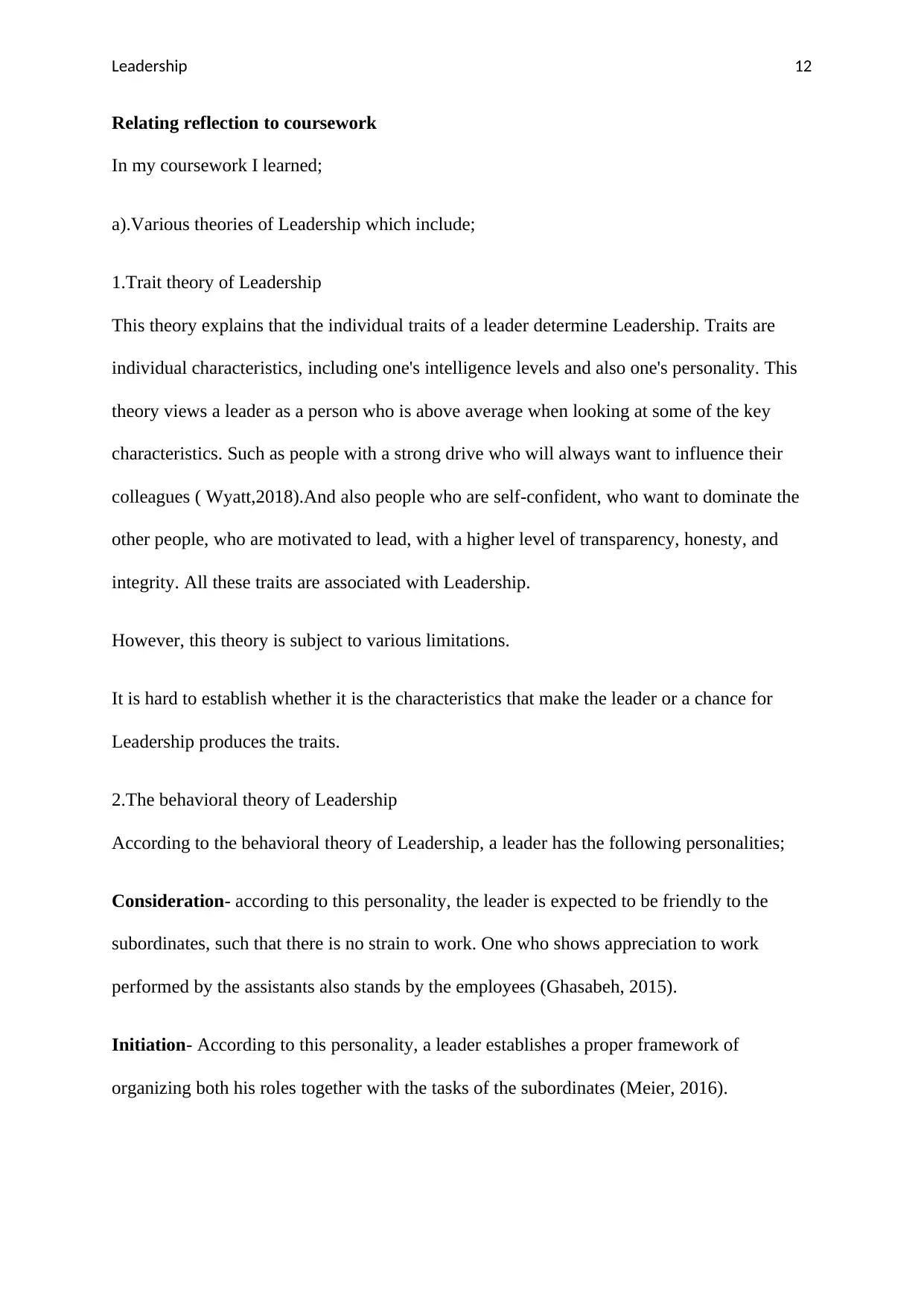
Leadership 12
Relating reflection to coursework
In my coursework I learned;
a).Various theories of Leadership which include;
1.Trait theory of Leadership
This theory explains that the individual traits of a leader determine Leadership. Traits are
individual characteristics, including one's intelligence levels and also one's personality. This
theory views a leader as a person who is above average when looking at some of the key
characteristics. Such as people with a strong drive who will always want to influence their
colleagues ( Wyatt,2018).And also people who are self-confident, who want to dominate the
other people, who are motivated to lead, with a higher level of transparency, honesty, and
integrity. All these traits are associated with Leadership.
However, this theory is subject to various limitations.
It is hard to establish whether it is the characteristics that make the leader or a chance for
Leadership produces the traits.
2.The behavioral theory of Leadership
According to the behavioral theory of Leadership, a leader has the following personalities;
Consideration- according to this personality, the leader is expected to be friendly to the
subordinates, such that there is no strain to work. One who shows appreciation to work
performed by the assistants also stands by the employees (Ghasabeh, 2015).
Initiation- According to this personality, a leader establishes a proper framework of
organizing both his roles together with the tasks of the subordinates (Meier, 2016).
Relating reflection to coursework
In my coursework I learned;
a).Various theories of Leadership which include;
1.Trait theory of Leadership
This theory explains that the individual traits of a leader determine Leadership. Traits are
individual characteristics, including one's intelligence levels and also one's personality. This
theory views a leader as a person who is above average when looking at some of the key
characteristics. Such as people with a strong drive who will always want to influence their
colleagues ( Wyatt,2018).And also people who are self-confident, who want to dominate the
other people, who are motivated to lead, with a higher level of transparency, honesty, and
integrity. All these traits are associated with Leadership.
However, this theory is subject to various limitations.
It is hard to establish whether it is the characteristics that make the leader or a chance for
Leadership produces the traits.
2.The behavioral theory of Leadership
According to the behavioral theory of Leadership, a leader has the following personalities;
Consideration- according to this personality, the leader is expected to be friendly to the
subordinates, such that there is no strain to work. One who shows appreciation to work
performed by the assistants also stands by the employees (Ghasabeh, 2015).
Initiation- According to this personality, a leader establishes a proper framework of
organizing both his roles together with the tasks of the subordinates (Meier, 2016).
You're viewing a preview
Unlock full access by subscribing today!
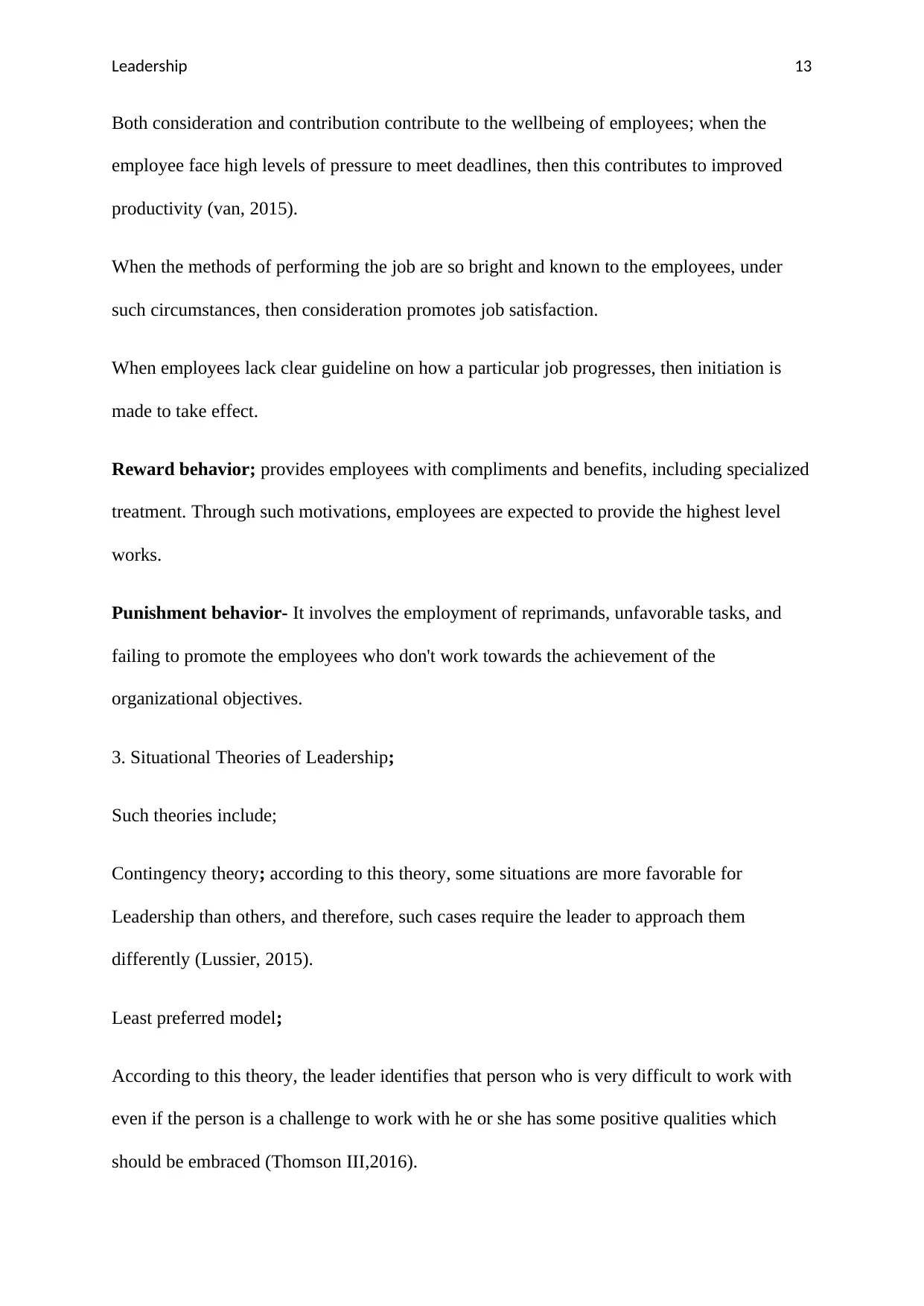
Leadership 13
Both consideration and contribution contribute to the wellbeing of employees; when the
employee face high levels of pressure to meet deadlines, then this contributes to improved
productivity (van, 2015).
When the methods of performing the job are so bright and known to the employees, under
such circumstances, then consideration promotes job satisfaction.
When employees lack clear guideline on how a particular job progresses, then initiation is
made to take effect.
Reward behavior; provides employees with compliments and benefits, including specialized
treatment. Through such motivations, employees are expected to provide the highest level
works.
Punishment behavior- It involves the employment of reprimands, unfavorable tasks, and
failing to promote the employees who don't work towards the achievement of the
organizational objectives.
3. Situational Theories of Leadership;
Such theories include;
Contingency theory; according to this theory, some situations are more favorable for
Leadership than others, and therefore, such cases require the leader to approach them
differently (Lussier, 2015).
Least preferred model;
According to this theory, the leader identifies that person who is very difficult to work with
even if the person is a challenge to work with he or she has some positive qualities which
should be embraced (Thomson III,2016).
Both consideration and contribution contribute to the wellbeing of employees; when the
employee face high levels of pressure to meet deadlines, then this contributes to improved
productivity (van, 2015).
When the methods of performing the job are so bright and known to the employees, under
such circumstances, then consideration promotes job satisfaction.
When employees lack clear guideline on how a particular job progresses, then initiation is
made to take effect.
Reward behavior; provides employees with compliments and benefits, including specialized
treatment. Through such motivations, employees are expected to provide the highest level
works.
Punishment behavior- It involves the employment of reprimands, unfavorable tasks, and
failing to promote the employees who don't work towards the achievement of the
organizational objectives.
3. Situational Theories of Leadership;
Such theories include;
Contingency theory; according to this theory, some situations are more favorable for
Leadership than others, and therefore, such cases require the leader to approach them
differently (Lussier, 2015).
Least preferred model;
According to this theory, the leader identifies that person who is very difficult to work with
even if the person is a challenge to work with he or she has some positive qualities which
should be embraced (Thomson III,2016).
Paraphrase This Document
Need a fresh take? Get an instant paraphrase of this document with our AI Paraphraser
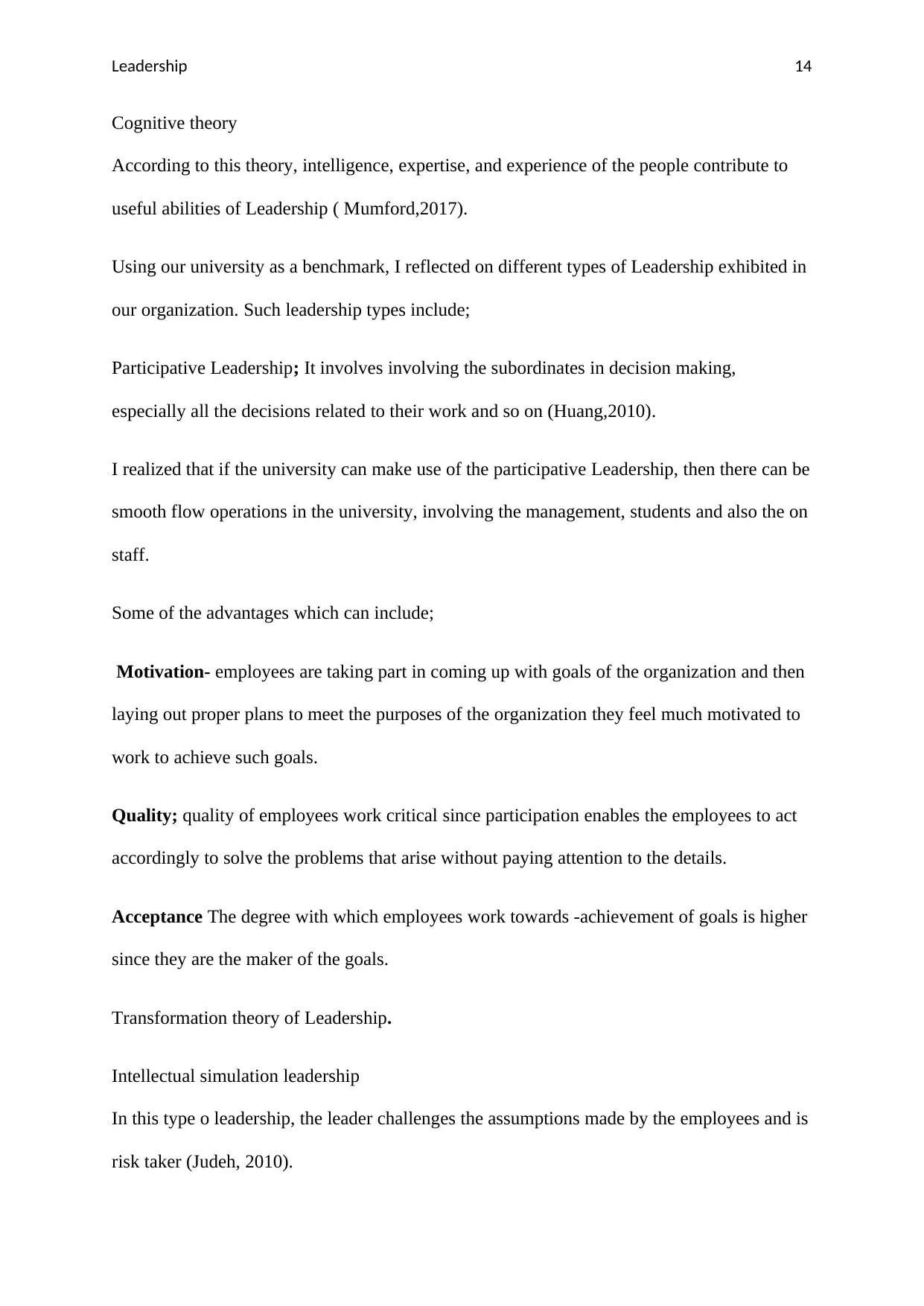
Leadership 14
Cognitive theory
According to this theory, intelligence, expertise, and experience of the people contribute to
useful abilities of Leadership ( Mumford,2017).
Using our university as a benchmark, I reflected on different types of Leadership exhibited in
our organization. Such leadership types include;
Participative Leadership; It involves involving the subordinates in decision making,
especially all the decisions related to their work and so on (Huang,2010).
I realized that if the university can make use of the participative Leadership, then there can be
smooth flow operations in the university, involving the management, students and also the on
staff.
Some of the advantages which can include;
Motivation- employees are taking part in coming up with goals of the organization and then
laying out proper plans to meet the purposes of the organization they feel much motivated to
work to achieve such goals.
Quality; quality of employees work critical since participation enables the employees to act
accordingly to solve the problems that arise without paying attention to the details.
Acceptance The degree with which employees work towards -achievement of goals is higher
since they are the maker of the goals.
Transformation theory of Leadership.
Intellectual simulation leadership
In this type o leadership, the leader challenges the assumptions made by the employees and is
risk taker (Judeh, 2010).
Cognitive theory
According to this theory, intelligence, expertise, and experience of the people contribute to
useful abilities of Leadership ( Mumford,2017).
Using our university as a benchmark, I reflected on different types of Leadership exhibited in
our organization. Such leadership types include;
Participative Leadership; It involves involving the subordinates in decision making,
especially all the decisions related to their work and so on (Huang,2010).
I realized that if the university can make use of the participative Leadership, then there can be
smooth flow operations in the university, involving the management, students and also the on
staff.
Some of the advantages which can include;
Motivation- employees are taking part in coming up with goals of the organization and then
laying out proper plans to meet the purposes of the organization they feel much motivated to
work to achieve such goals.
Quality; quality of employees work critical since participation enables the employees to act
accordingly to solve the problems that arise without paying attention to the details.
Acceptance The degree with which employees work towards -achievement of goals is higher
since they are the maker of the goals.
Transformation theory of Leadership.
Intellectual simulation leadership
In this type o leadership, the leader challenges the assumptions made by the employees and is
risk taker (Judeh, 2010).
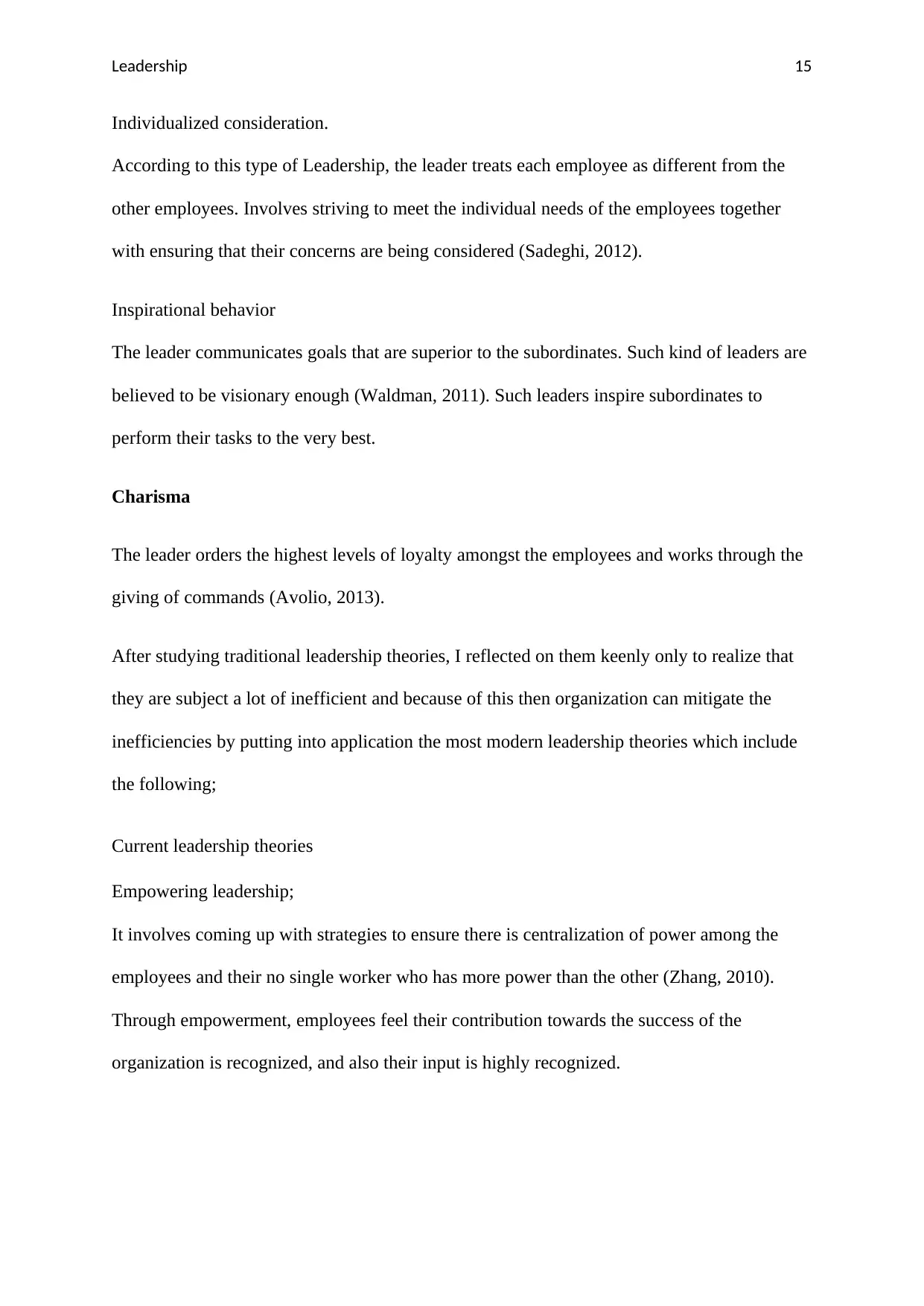
Leadership 15
Individualized consideration.
According to this type of Leadership, the leader treats each employee as different from the
other employees. Involves striving to meet the individual needs of the employees together
with ensuring that their concerns are being considered (Sadeghi, 2012).
Inspirational behavior
The leader communicates goals that are superior to the subordinates. Such kind of leaders are
believed to be visionary enough (Waldman, 2011). Such leaders inspire subordinates to
perform their tasks to the very best.
Charisma
The leader orders the highest levels of loyalty amongst the employees and works through the
giving of commands (Avolio, 2013).
After studying traditional leadership theories, I reflected on them keenly only to realize that
they are subject a lot of inefficient and because of this then organization can mitigate the
inefficiencies by putting into application the most modern leadership theories which include
the following;
Current leadership theories
Empowering leadership;
It involves coming up with strategies to ensure there is centralization of power among the
employees and their no single worker who has more power than the other (Zhang, 2010).
Through empowerment, employees feel their contribution towards the success of the
organization is recognized, and also their input is highly recognized.
Individualized consideration.
According to this type of Leadership, the leader treats each employee as different from the
other employees. Involves striving to meet the individual needs of the employees together
with ensuring that their concerns are being considered (Sadeghi, 2012).
Inspirational behavior
The leader communicates goals that are superior to the subordinates. Such kind of leaders are
believed to be visionary enough (Waldman, 2011). Such leaders inspire subordinates to
perform their tasks to the very best.
Charisma
The leader orders the highest levels of loyalty amongst the employees and works through the
giving of commands (Avolio, 2013).
After studying traditional leadership theories, I reflected on them keenly only to realize that
they are subject a lot of inefficient and because of this then organization can mitigate the
inefficiencies by putting into application the most modern leadership theories which include
the following;
Current leadership theories
Empowering leadership;
It involves coming up with strategies to ensure there is centralization of power among the
employees and their no single worker who has more power than the other (Zhang, 2010).
Through empowerment, employees feel their contribution towards the success of the
organization is recognized, and also their input is highly recognized.
You're viewing a preview
Unlock full access by subscribing today!
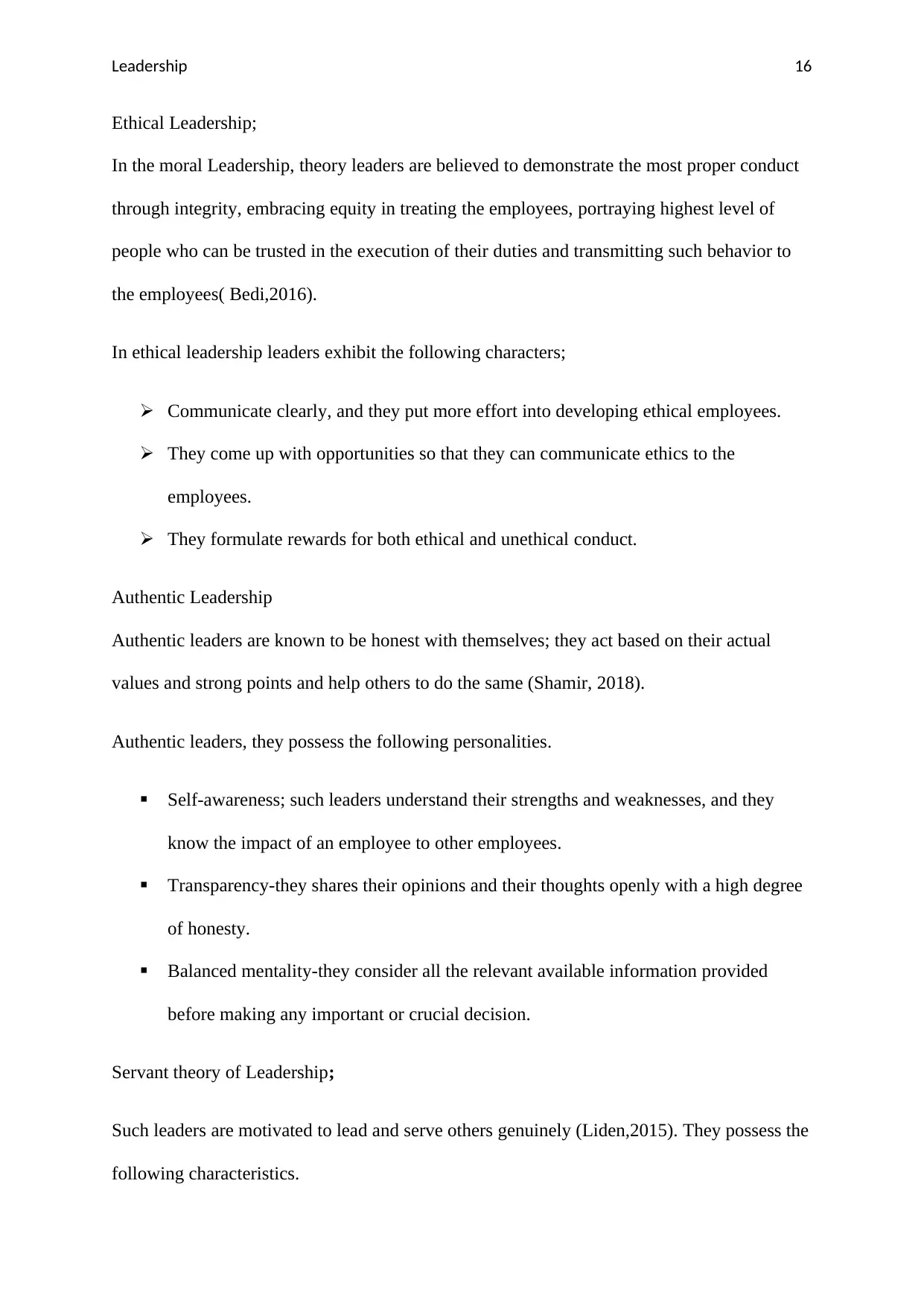
Leadership 16
Ethical Leadership;
In the moral Leadership, theory leaders are believed to demonstrate the most proper conduct
through integrity, embracing equity in treating the employees, portraying highest level of
people who can be trusted in the execution of their duties and transmitting such behavior to
the employees( Bedi,2016).
In ethical leadership leaders exhibit the following characters;
Communicate clearly, and they put more effort into developing ethical employees.
They come up with opportunities so that they can communicate ethics to the
employees.
They formulate rewards for both ethical and unethical conduct.
Authentic Leadership
Authentic leaders are known to be honest with themselves; they act based on their actual
values and strong points and help others to do the same (Shamir, 2018).
Authentic leaders, they possess the following personalities.
Self-awareness; such leaders understand their strengths and weaknesses, and they
know the impact of an employee to other employees.
Transparency-they shares their opinions and their thoughts openly with a high degree
of honesty.
Balanced mentality-they consider all the relevant available information provided
before making any important or crucial decision.
Servant theory of Leadership;
Such leaders are motivated to lead and serve others genuinely (Liden,2015). They possess the
following characteristics.
Ethical Leadership;
In the moral Leadership, theory leaders are believed to demonstrate the most proper conduct
through integrity, embracing equity in treating the employees, portraying highest level of
people who can be trusted in the execution of their duties and transmitting such behavior to
the employees( Bedi,2016).
In ethical leadership leaders exhibit the following characters;
Communicate clearly, and they put more effort into developing ethical employees.
They come up with opportunities so that they can communicate ethics to the
employees.
They formulate rewards for both ethical and unethical conduct.
Authentic Leadership
Authentic leaders are known to be honest with themselves; they act based on their actual
values and strong points and help others to do the same (Shamir, 2018).
Authentic leaders, they possess the following personalities.
Self-awareness; such leaders understand their strengths and weaknesses, and they
know the impact of an employee to other employees.
Transparency-they shares their opinions and their thoughts openly with a high degree
of honesty.
Balanced mentality-they consider all the relevant available information provided
before making any important or crucial decision.
Servant theory of Leadership;
Such leaders are motivated to lead and serve others genuinely (Liden,2015). They possess the
following characteristics.
Paraphrase This Document
Need a fresh take? Get an instant paraphrase of this document with our AI Paraphraser
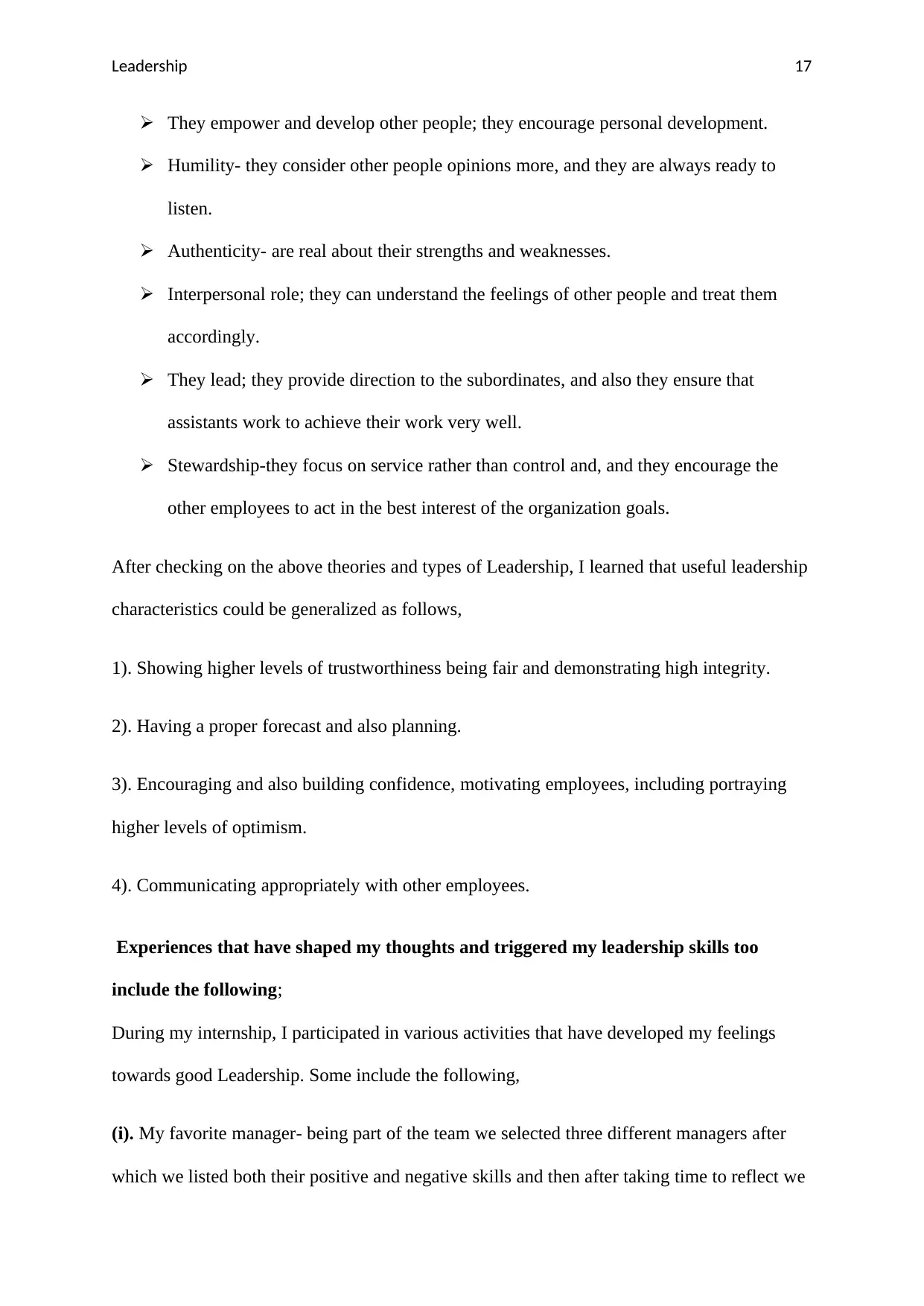
Leadership 17
They empower and develop other people; they encourage personal development.
Humility- they consider other people opinions more, and they are always ready to
listen.
Authenticity- are real about their strengths and weaknesses.
Interpersonal role; they can understand the feelings of other people and treat them
accordingly.
They lead; they provide direction to the subordinates, and also they ensure that
assistants work to achieve their work very well.
Stewardship-they focus on service rather than control and, and they encourage the
other employees to act in the best interest of the organization goals.
After checking on the above theories and types of Leadership, I learned that useful leadership
characteristics could be generalized as follows,
1). Showing higher levels of trustworthiness being fair and demonstrating high integrity.
2). Having a proper forecast and also planning.
3). Encouraging and also building confidence, motivating employees, including portraying
higher levels of optimism.
4). Communicating appropriately with other employees.
Experiences that have shaped my thoughts and triggered my leadership skills too
include the following;
During my internship, I participated in various activities that have developed my feelings
towards good Leadership. Some include the following,
(i). My favorite manager- being part of the team we selected three different managers after
which we listed both their positive and negative skills and then after taking time to reflect we
They empower and develop other people; they encourage personal development.
Humility- they consider other people opinions more, and they are always ready to
listen.
Authenticity- are real about their strengths and weaknesses.
Interpersonal role; they can understand the feelings of other people and treat them
accordingly.
They lead; they provide direction to the subordinates, and also they ensure that
assistants work to achieve their work very well.
Stewardship-they focus on service rather than control and, and they encourage the
other employees to act in the best interest of the organization goals.
After checking on the above theories and types of Leadership, I learned that useful leadership
characteristics could be generalized as follows,
1). Showing higher levels of trustworthiness being fair and demonstrating high integrity.
2). Having a proper forecast and also planning.
3). Encouraging and also building confidence, motivating employees, including portraying
higher levels of optimism.
4). Communicating appropriately with other employees.
Experiences that have shaped my thoughts and triggered my leadership skills too
include the following;
During my internship, I participated in various activities that have developed my feelings
towards good Leadership. Some include the following,
(i). My favorite manager- being part of the team we selected three different managers after
which we listed both their positive and negative skills and then after taking time to reflect we
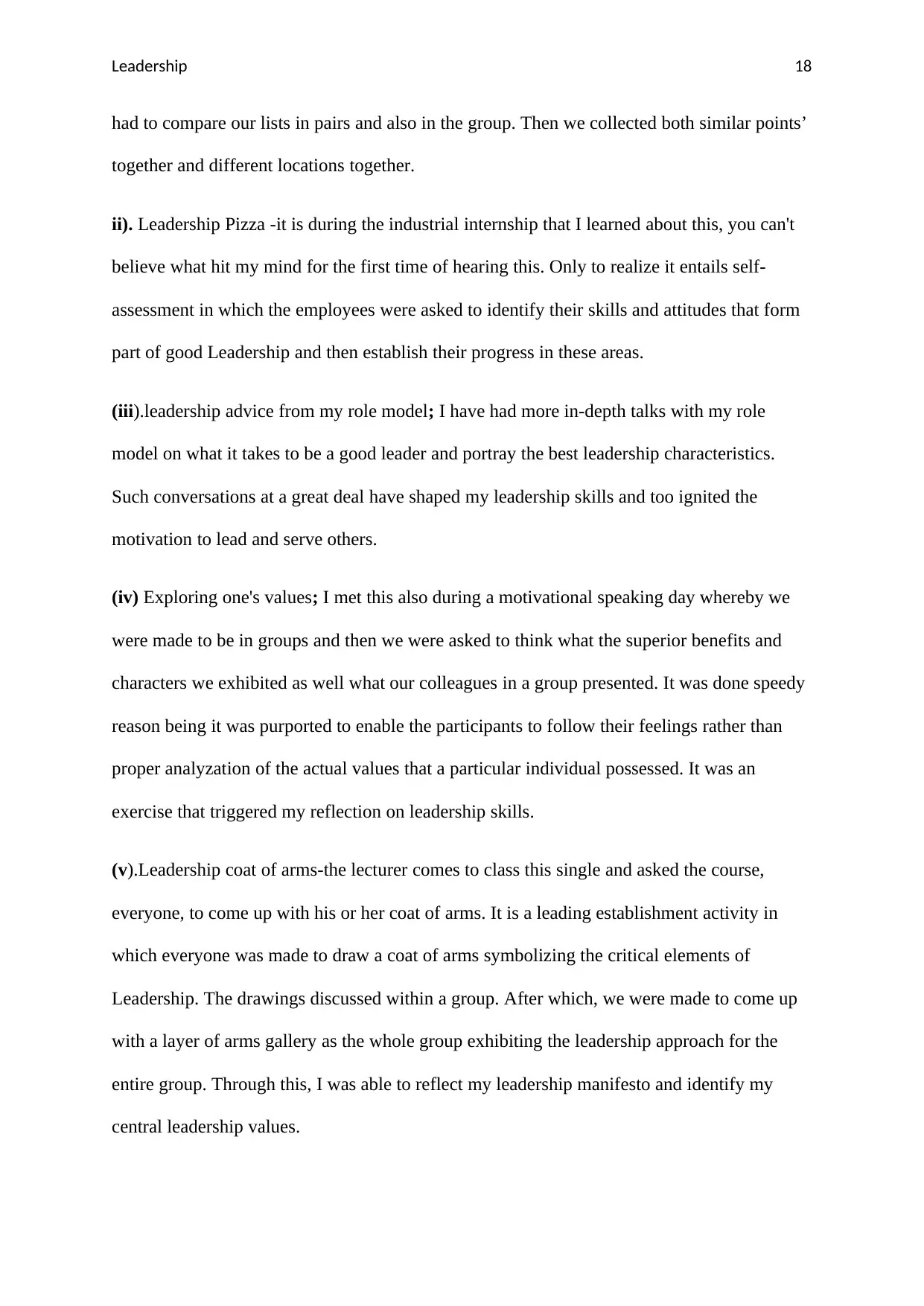
Leadership 18
had to compare our lists in pairs and also in the group. Then we collected both similar points’
together and different locations together.
ii). Leadership Pizza -it is during the industrial internship that I learned about this, you can't
believe what hit my mind for the first time of hearing this. Only to realize it entails self-
assessment in which the employees were asked to identify their skills and attitudes that form
part of good Leadership and then establish their progress in these areas.
(iii).leadership advice from my role model; I have had more in-depth talks with my role
model on what it takes to be a good leader and portray the best leadership characteristics.
Such conversations at a great deal have shaped my leadership skills and too ignited the
motivation to lead and serve others.
(iv) Exploring one's values; I met this also during a motivational speaking day whereby we
were made to be in groups and then we were asked to think what the superior benefits and
characters we exhibited as well what our colleagues in a group presented. It was done speedy
reason being it was purported to enable the participants to follow their feelings rather than
proper analyzation of the actual values that a particular individual possessed. It was an
exercise that triggered my reflection on leadership skills.
(v).Leadership coat of arms-the lecturer comes to class this single and asked the course,
everyone, to come up with his or her coat of arms. It is a leading establishment activity in
which everyone was made to draw a coat of arms symbolizing the critical elements of
Leadership. The drawings discussed within a group. After which, we were made to come up
with a layer of arms gallery as the whole group exhibiting the leadership approach for the
entire group. Through this, I was able to reflect my leadership manifesto and identify my
central leadership values.
had to compare our lists in pairs and also in the group. Then we collected both similar points’
together and different locations together.
ii). Leadership Pizza -it is during the industrial internship that I learned about this, you can't
believe what hit my mind for the first time of hearing this. Only to realize it entails self-
assessment in which the employees were asked to identify their skills and attitudes that form
part of good Leadership and then establish their progress in these areas.
(iii).leadership advice from my role model; I have had more in-depth talks with my role
model on what it takes to be a good leader and portray the best leadership characteristics.
Such conversations at a great deal have shaped my leadership skills and too ignited the
motivation to lead and serve others.
(iv) Exploring one's values; I met this also during a motivational speaking day whereby we
were made to be in groups and then we were asked to think what the superior benefits and
characters we exhibited as well what our colleagues in a group presented. It was done speedy
reason being it was purported to enable the participants to follow their feelings rather than
proper analyzation of the actual values that a particular individual possessed. It was an
exercise that triggered my reflection on leadership skills.
(v).Leadership coat of arms-the lecturer comes to class this single and asked the course,
everyone, to come up with his or her coat of arms. It is a leading establishment activity in
which everyone was made to draw a coat of arms symbolizing the critical elements of
Leadership. The drawings discussed within a group. After which, we were made to come up
with a layer of arms gallery as the whole group exhibiting the leadership approach for the
entire group. Through this, I was able to reflect my leadership manifesto and identify my
central leadership values.
You're viewing a preview
Unlock full access by subscribing today!
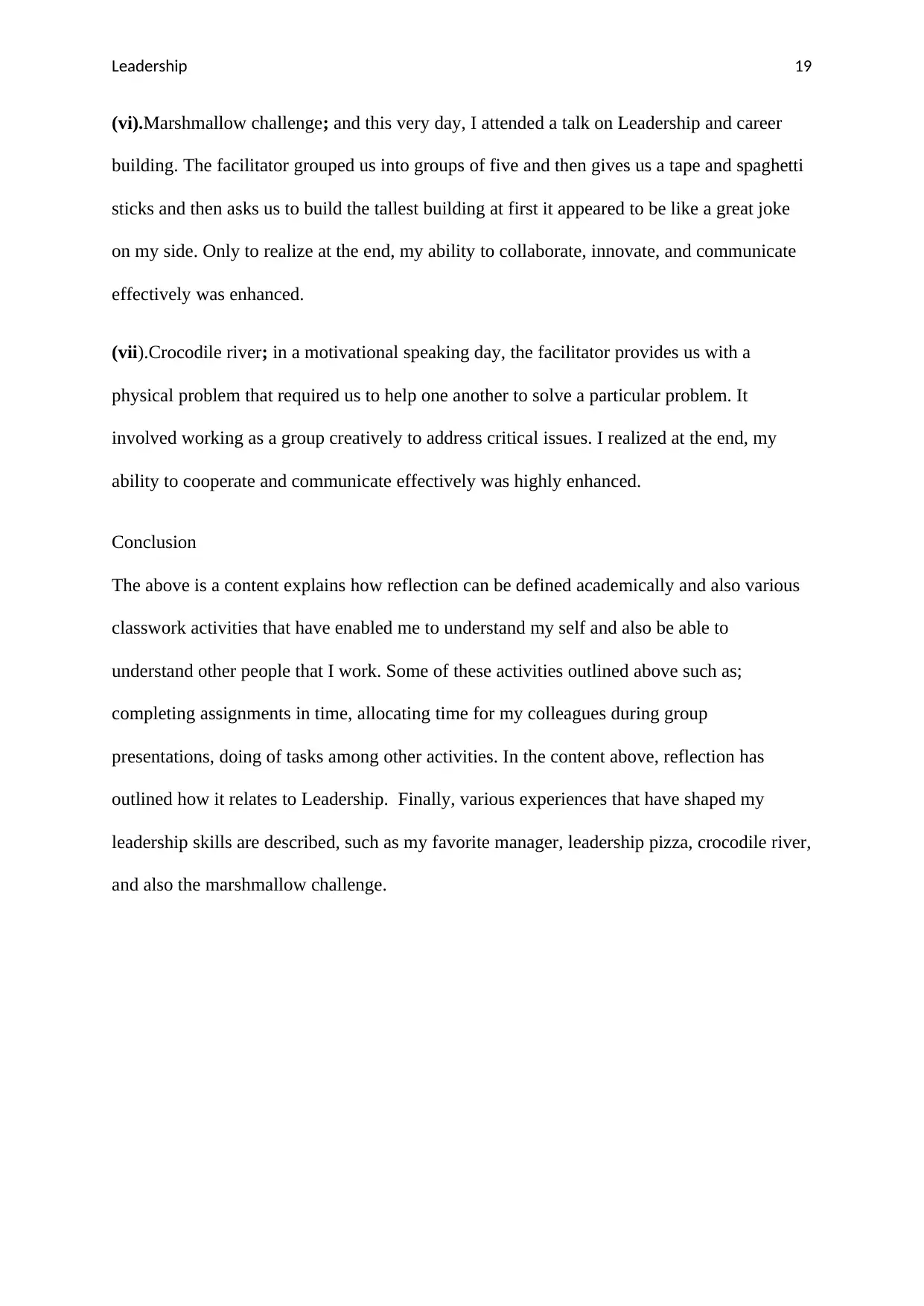
Leadership 19
(vi).Marshmallow challenge; and this very day, I attended a talk on Leadership and career
building. The facilitator grouped us into groups of five and then gives us a tape and spaghetti
sticks and then asks us to build the tallest building at first it appeared to be like a great joke
on my side. Only to realize at the end, my ability to collaborate, innovate, and communicate
effectively was enhanced.
(vii).Crocodile river; in a motivational speaking day, the facilitator provides us with a
physical problem that required us to help one another to solve a particular problem. It
involved working as a group creatively to address critical issues. I realized at the end, my
ability to cooperate and communicate effectively was highly enhanced.
Conclusion
The above is a content explains how reflection can be defined academically and also various
classwork activities that have enabled me to understand my self and also be able to
understand other people that I work. Some of these activities outlined above such as;
completing assignments in time, allocating time for my colleagues during group
presentations, doing of tasks among other activities. In the content above, reflection has
outlined how it relates to Leadership. Finally, various experiences that have shaped my
leadership skills are described, such as my favorite manager, leadership pizza, crocodile river,
and also the marshmallow challenge.
(vi).Marshmallow challenge; and this very day, I attended a talk on Leadership and career
building. The facilitator grouped us into groups of five and then gives us a tape and spaghetti
sticks and then asks us to build the tallest building at first it appeared to be like a great joke
on my side. Only to realize at the end, my ability to collaborate, innovate, and communicate
effectively was enhanced.
(vii).Crocodile river; in a motivational speaking day, the facilitator provides us with a
physical problem that required us to help one another to solve a particular problem. It
involved working as a group creatively to address critical issues. I realized at the end, my
ability to cooperate and communicate effectively was highly enhanced.
Conclusion
The above is a content explains how reflection can be defined academically and also various
classwork activities that have enabled me to understand my self and also be able to
understand other people that I work. Some of these activities outlined above such as;
completing assignments in time, allocating time for my colleagues during group
presentations, doing of tasks among other activities. In the content above, reflection has
outlined how it relates to Leadership. Finally, various experiences that have shaped my
leadership skills are described, such as my favorite manager, leadership pizza, crocodile river,
and also the marshmallow challenge.
Paraphrase This Document
Need a fresh take? Get an instant paraphrase of this document with our AI Paraphraser
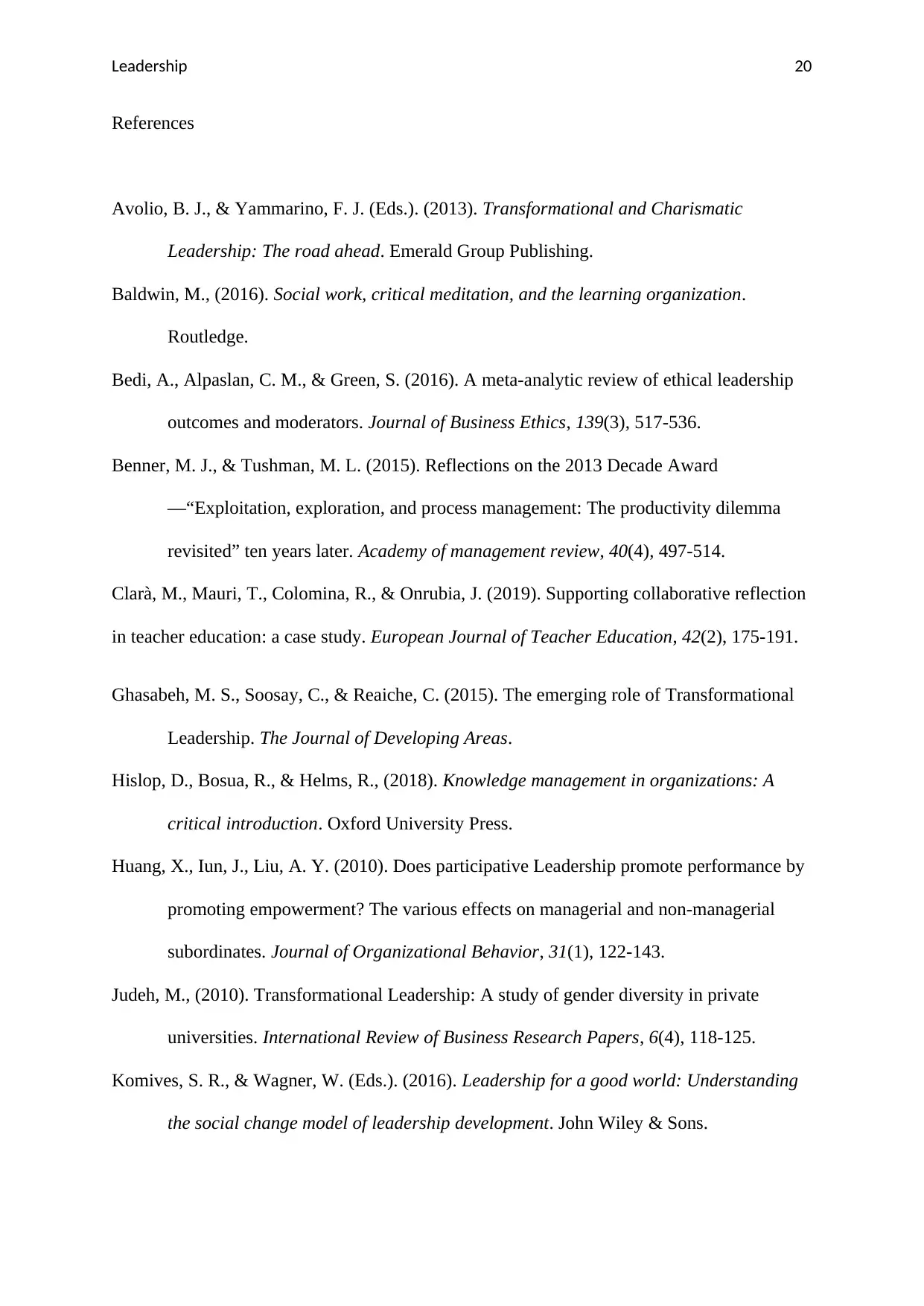
Leadership 20
References
Avolio, B. J., & Yammarino, F. J. (Eds.). (2013). Transformational and Charismatic
Leadership: The road ahead. Emerald Group Publishing.
Baldwin, M., (2016). Social work, critical meditation, and the learning organization.
Routledge.
Bedi, A., Alpaslan, C. M., & Green, S. (2016). A meta-analytic review of ethical leadership
outcomes and moderators. Journal of Business Ethics, 139(3), 517-536.
Benner, M. J., & Tushman, M. L. (2015). Reflections on the 2013 Decade Award
—“Exploitation, exploration, and process management: The productivity dilemma
revisited” ten years later. Academy of management review, 40(4), 497-514.
Clarà, M., Mauri, T., Colomina, R., & Onrubia, J. (2019). Supporting collaborative reflection
in teacher education: a case study. European Journal of Teacher Education, 42(2), 175-191.
Ghasabeh, M. S., Soosay, C., & Reaiche, C. (2015). The emerging role of Transformational
Leadership. The Journal of Developing Areas.
Hislop, D., Bosua, R., & Helms, R., (2018). Knowledge management in organizations: A
critical introduction. Oxford University Press.
Huang, X., Iun, J., Liu, A. Y. (2010). Does participative Leadership promote performance by
promoting empowerment? The various effects on managerial and non‐managerial
subordinates. Journal of Organizational Behavior, 31(1), 122-143.
Judeh, M., (2010). Transformational Leadership: A study of gender diversity in private
universities. International Review of Business Research Papers, 6(4), 118-125.
Komives, S. R., & Wagner, W. (Eds.). (2016). Leadership for a good world: Understanding
the social change model of leadership development. John Wiley & Sons.
References
Avolio, B. J., & Yammarino, F. J. (Eds.). (2013). Transformational and Charismatic
Leadership: The road ahead. Emerald Group Publishing.
Baldwin, M., (2016). Social work, critical meditation, and the learning organization.
Routledge.
Bedi, A., Alpaslan, C. M., & Green, S. (2016). A meta-analytic review of ethical leadership
outcomes and moderators. Journal of Business Ethics, 139(3), 517-536.
Benner, M. J., & Tushman, M. L. (2015). Reflections on the 2013 Decade Award
—“Exploitation, exploration, and process management: The productivity dilemma
revisited” ten years later. Academy of management review, 40(4), 497-514.
Clarà, M., Mauri, T., Colomina, R., & Onrubia, J. (2019). Supporting collaborative reflection
in teacher education: a case study. European Journal of Teacher Education, 42(2), 175-191.
Ghasabeh, M. S., Soosay, C., & Reaiche, C. (2015). The emerging role of Transformational
Leadership. The Journal of Developing Areas.
Hislop, D., Bosua, R., & Helms, R., (2018). Knowledge management in organizations: A
critical introduction. Oxford University Press.
Huang, X., Iun, J., Liu, A. Y. (2010). Does participative Leadership promote performance by
promoting empowerment? The various effects on managerial and non‐managerial
subordinates. Journal of Organizational Behavior, 31(1), 122-143.
Judeh, M., (2010). Transformational Leadership: A study of gender diversity in private
universities. International Review of Business Research Papers, 6(4), 118-125.
Komives, S. R., & Wagner, W. (Eds.). (2016). Leadership for a good world: Understanding
the social change model of leadership development. John Wiley & Sons.
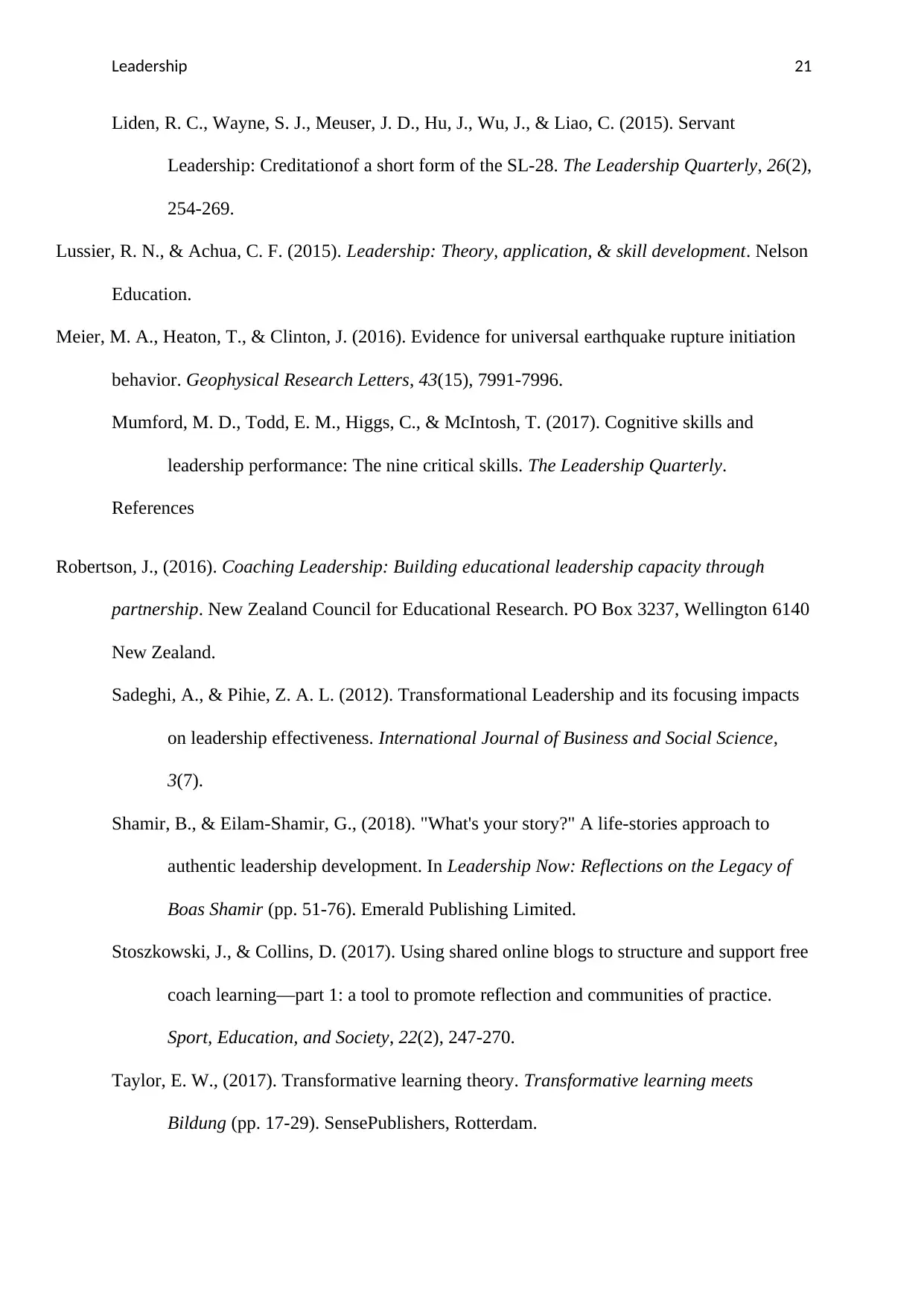
Leadership 21
Liden, R. C., Wayne, S. J., Meuser, J. D., Hu, J., Wu, J., & Liao, C. (2015). Servant
Leadership: Creditationof a short form of the SL-28. The Leadership Quarterly, 26(2),
254-269.
Lussier, R. N., & Achua, C. F. (2015). Leadership: Theory, application, & skill development. Nelson
Education.
Meier, M. A., Heaton, T., & Clinton, J. (2016). Evidence for universal earthquake rupture initiation
behavior. Geophysical Research Letters, 43(15), 7991-7996.
Mumford, M. D., Todd, E. M., Higgs, C., & McIntosh, T. (2017). Cognitive skills and
leadership performance: The nine critical skills. The Leadership Quarterly.
References
Robertson, J., (2016). Coaching Leadership: Building educational leadership capacity through
partnership. New Zealand Council for Educational Research. PO Box 3237, Wellington 6140
New Zealand.
Sadeghi, A., & Pihie, Z. A. L. (2012). Transformational Leadership and its focusing impacts
on leadership effectiveness. International Journal of Business and Social Science,
3(7).
Shamir, B., & Eilam-Shamir, G., (2018). "What's your story?" A life-stories approach to
authentic leadership development. In Leadership Now: Reflections on the Legacy of
Boas Shamir (pp. 51-76). Emerald Publishing Limited.
Stoszkowski, J., & Collins, D. (2017). Using shared online blogs to structure and support free
coach learning—part 1: a tool to promote reflection and communities of practice.
Sport, Education, and Society, 22(2), 247-270.
Taylor, E. W., (2017). Transformative learning theory. Transformative learning meets
Bildung (pp. 17-29). SensePublishers, Rotterdam.
Liden, R. C., Wayne, S. J., Meuser, J. D., Hu, J., Wu, J., & Liao, C. (2015). Servant
Leadership: Creditationof a short form of the SL-28. The Leadership Quarterly, 26(2),
254-269.
Lussier, R. N., & Achua, C. F. (2015). Leadership: Theory, application, & skill development. Nelson
Education.
Meier, M. A., Heaton, T., & Clinton, J. (2016). Evidence for universal earthquake rupture initiation
behavior. Geophysical Research Letters, 43(15), 7991-7996.
Mumford, M. D., Todd, E. M., Higgs, C., & McIntosh, T. (2017). Cognitive skills and
leadership performance: The nine critical skills. The Leadership Quarterly.
References
Robertson, J., (2016). Coaching Leadership: Building educational leadership capacity through
partnership. New Zealand Council for Educational Research. PO Box 3237, Wellington 6140
New Zealand.
Sadeghi, A., & Pihie, Z. A. L. (2012). Transformational Leadership and its focusing impacts
on leadership effectiveness. International Journal of Business and Social Science,
3(7).
Shamir, B., & Eilam-Shamir, G., (2018). "What's your story?" A life-stories approach to
authentic leadership development. In Leadership Now: Reflections on the Legacy of
Boas Shamir (pp. 51-76). Emerald Publishing Limited.
Stoszkowski, J., & Collins, D. (2017). Using shared online blogs to structure and support free
coach learning—part 1: a tool to promote reflection and communities of practice.
Sport, Education, and Society, 22(2), 247-270.
Taylor, E. W., (2017). Transformative learning theory. Transformative learning meets
Bildung (pp. 17-29). SensePublishers, Rotterdam.
You're viewing a preview
Unlock full access by subscribing today!
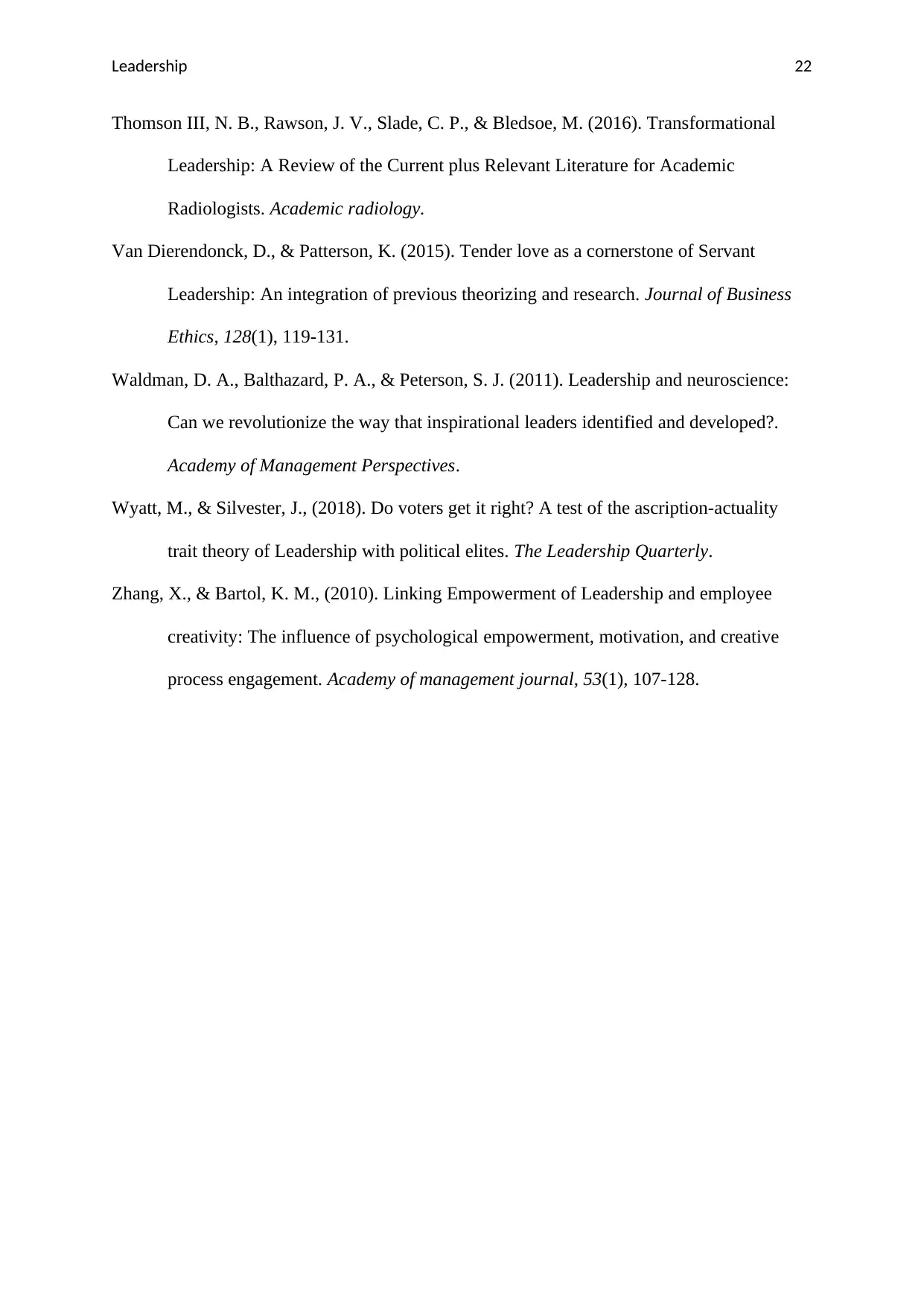
Leadership 22
Thomson III, N. B., Rawson, J. V., Slade, C. P., & Bledsoe, M. (2016). Transformational
Leadership: A Review of the Current plus Relevant Literature for Academic
Radiologists. Academic radiology.
Van Dierendonck, D., & Patterson, K. (2015). Tender love as a cornerstone of Servant
Leadership: An integration of previous theorizing and research. Journal of Business
Ethics, 128(1), 119-131.
Waldman, D. A., Balthazard, P. A., & Peterson, S. J. (2011). Leadership and neuroscience:
Can we revolutionize the way that inspirational leaders identified and developed?.
Academy of Management Perspectives.
Wyatt, M., & Silvester, J., (2018). Do voters get it right? A test of the ascription-actuality
trait theory of Leadership with political elites. The Leadership Quarterly.
Zhang, X., & Bartol, K. M., (2010). Linking Empowerment of Leadership and employee
creativity: The influence of psychological empowerment, motivation, and creative
process engagement. Academy of management journal, 53(1), 107-128.
Thomson III, N. B., Rawson, J. V., Slade, C. P., & Bledsoe, M. (2016). Transformational
Leadership: A Review of the Current plus Relevant Literature for Academic
Radiologists. Academic radiology.
Van Dierendonck, D., & Patterson, K. (2015). Tender love as a cornerstone of Servant
Leadership: An integration of previous theorizing and research. Journal of Business
Ethics, 128(1), 119-131.
Waldman, D. A., Balthazard, P. A., & Peterson, S. J. (2011). Leadership and neuroscience:
Can we revolutionize the way that inspirational leaders identified and developed?.
Academy of Management Perspectives.
Wyatt, M., & Silvester, J., (2018). Do voters get it right? A test of the ascription-actuality
trait theory of Leadership with political elites. The Leadership Quarterly.
Zhang, X., & Bartol, K. M., (2010). Linking Empowerment of Leadership and employee
creativity: The influence of psychological empowerment, motivation, and creative
process engagement. Academy of management journal, 53(1), 107-128.
1 out of 22
Related Documents
Your All-in-One AI-Powered Toolkit for Academic Success.
+13062052269
info@desklib.com
Available 24*7 on WhatsApp / Email
![[object Object]](/_next/static/media/star-bottom.7253800d.svg)
Unlock your academic potential
© 2024 | Zucol Services PVT LTD | All rights reserved.





